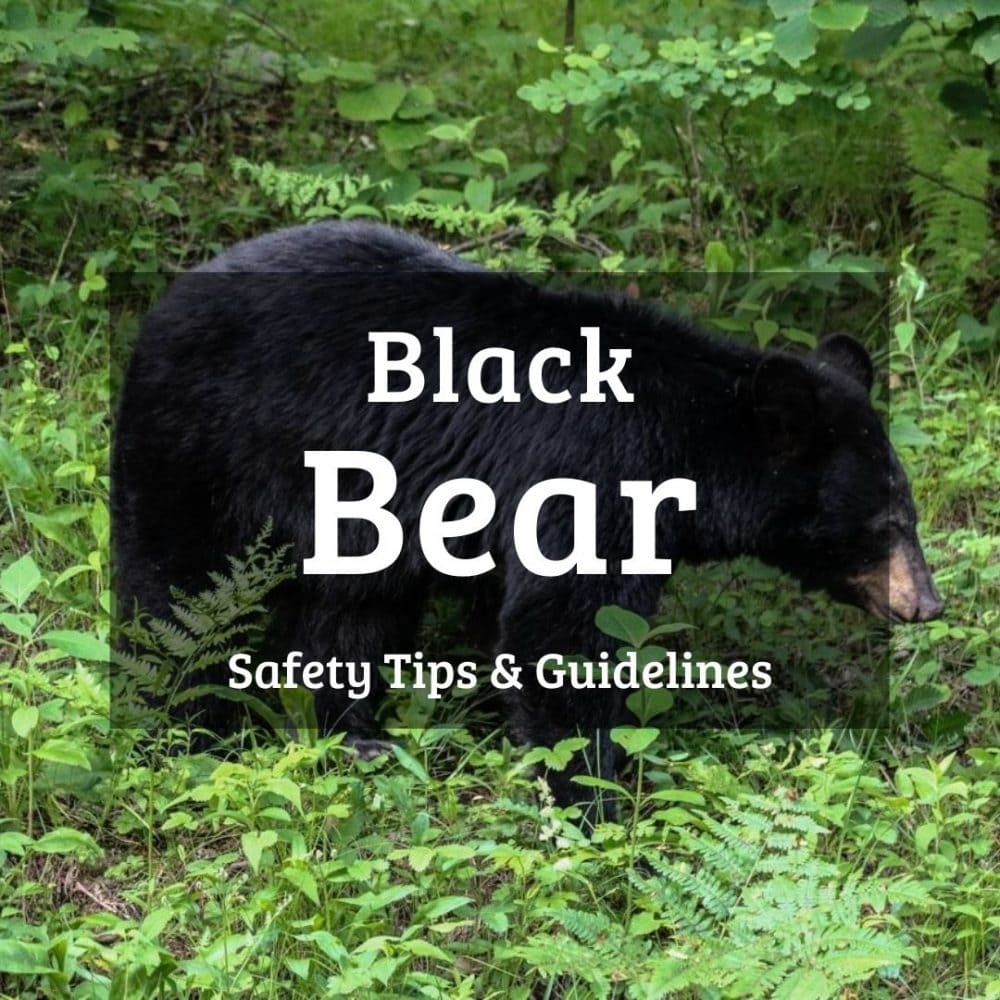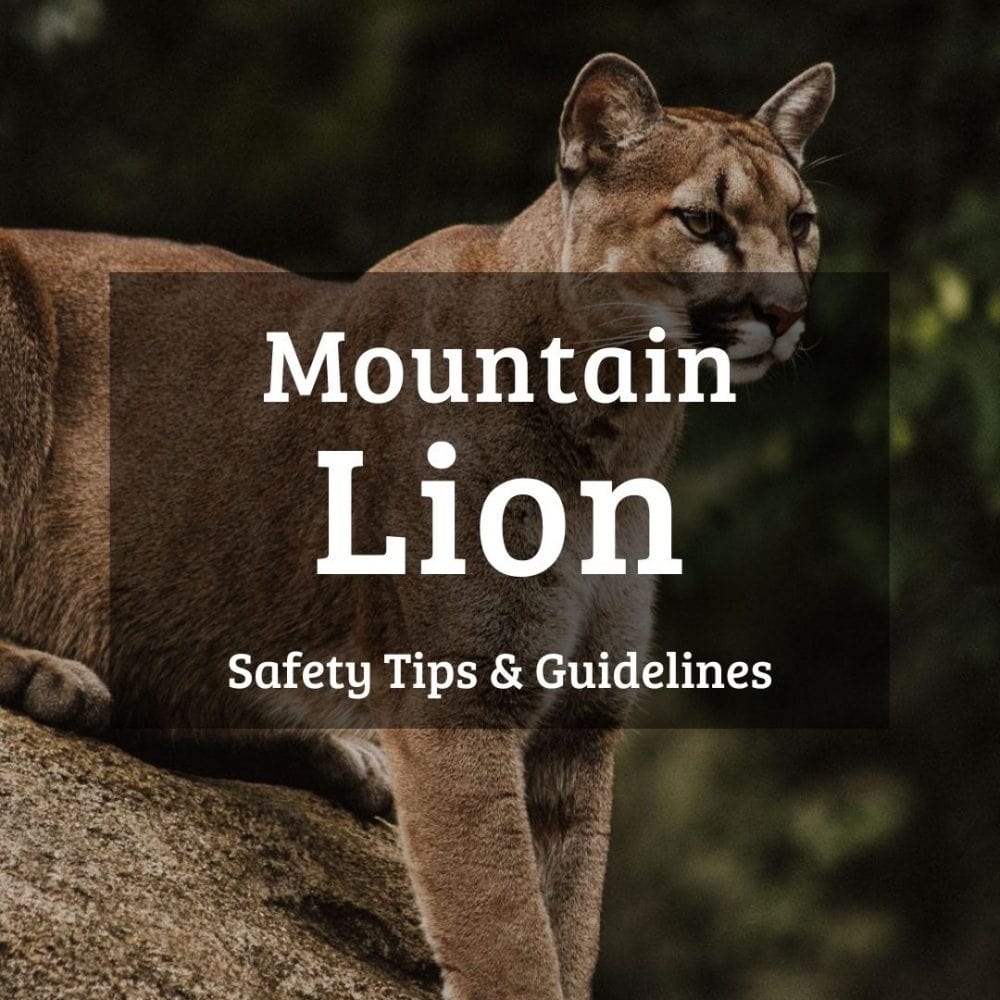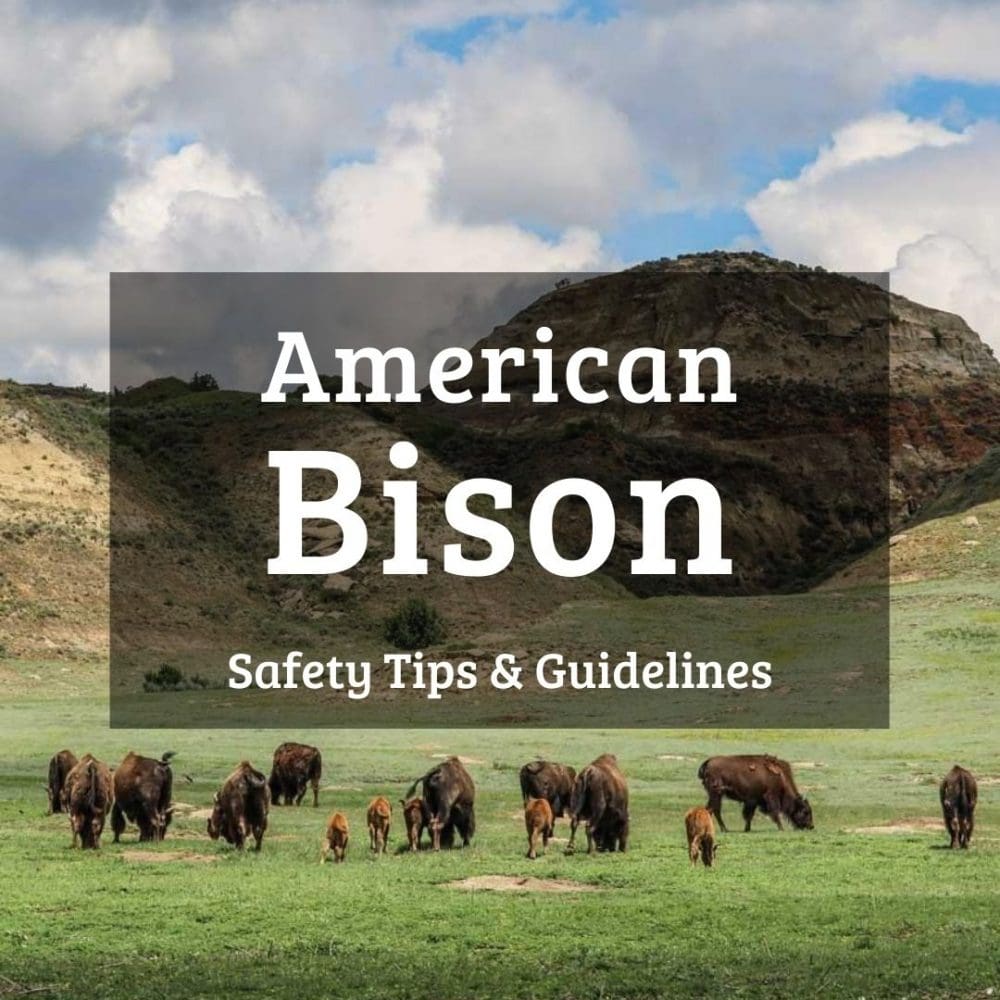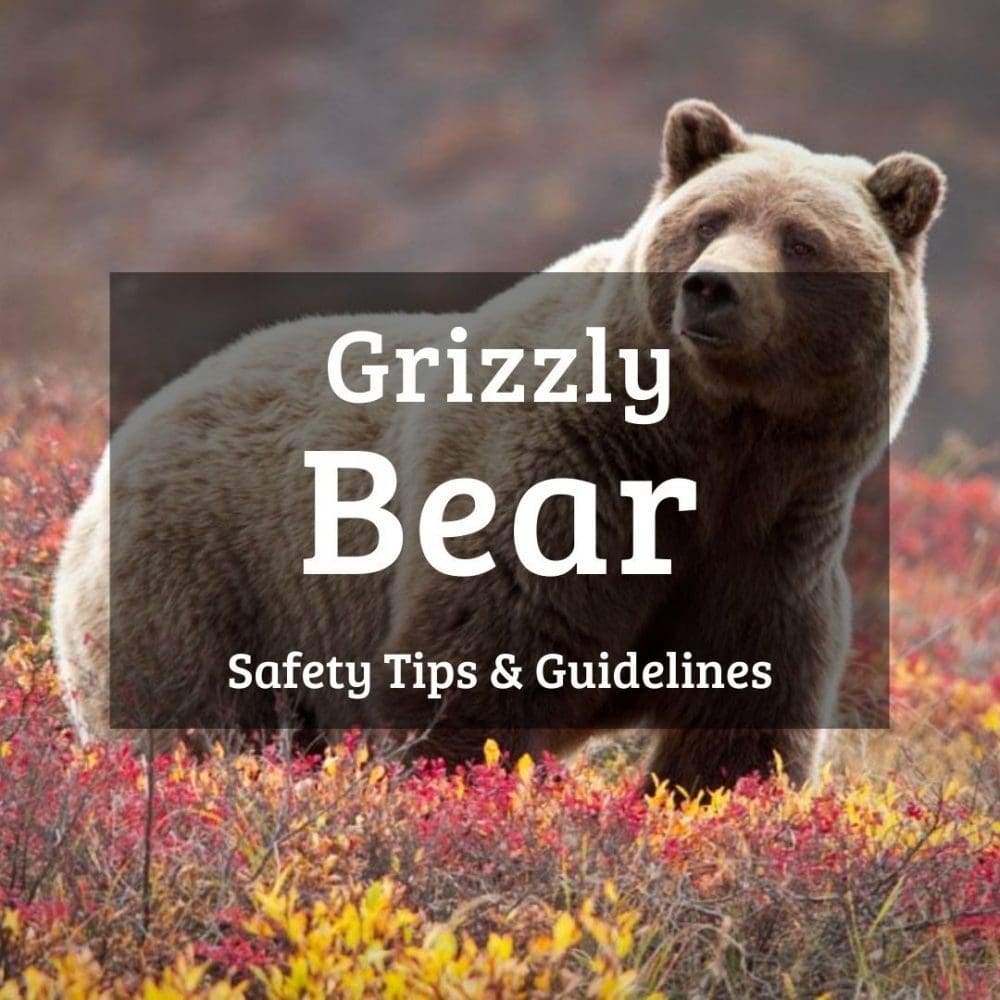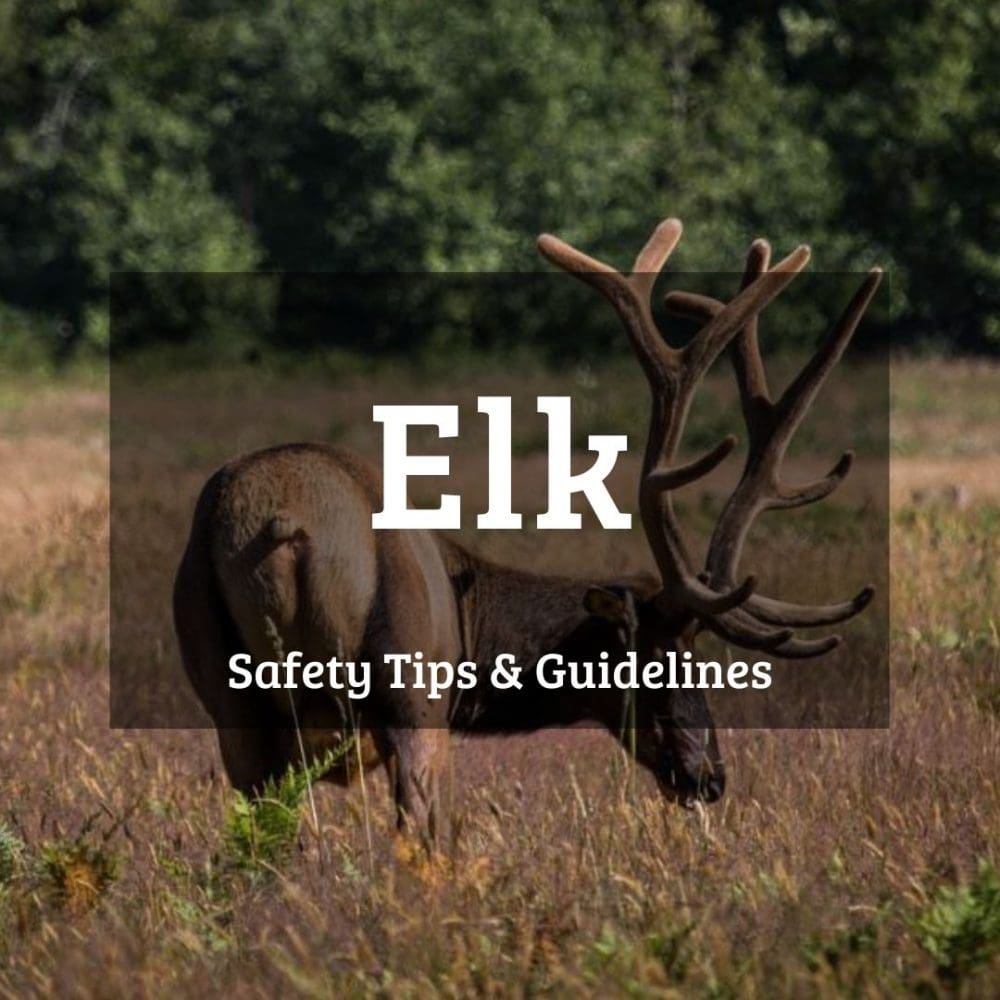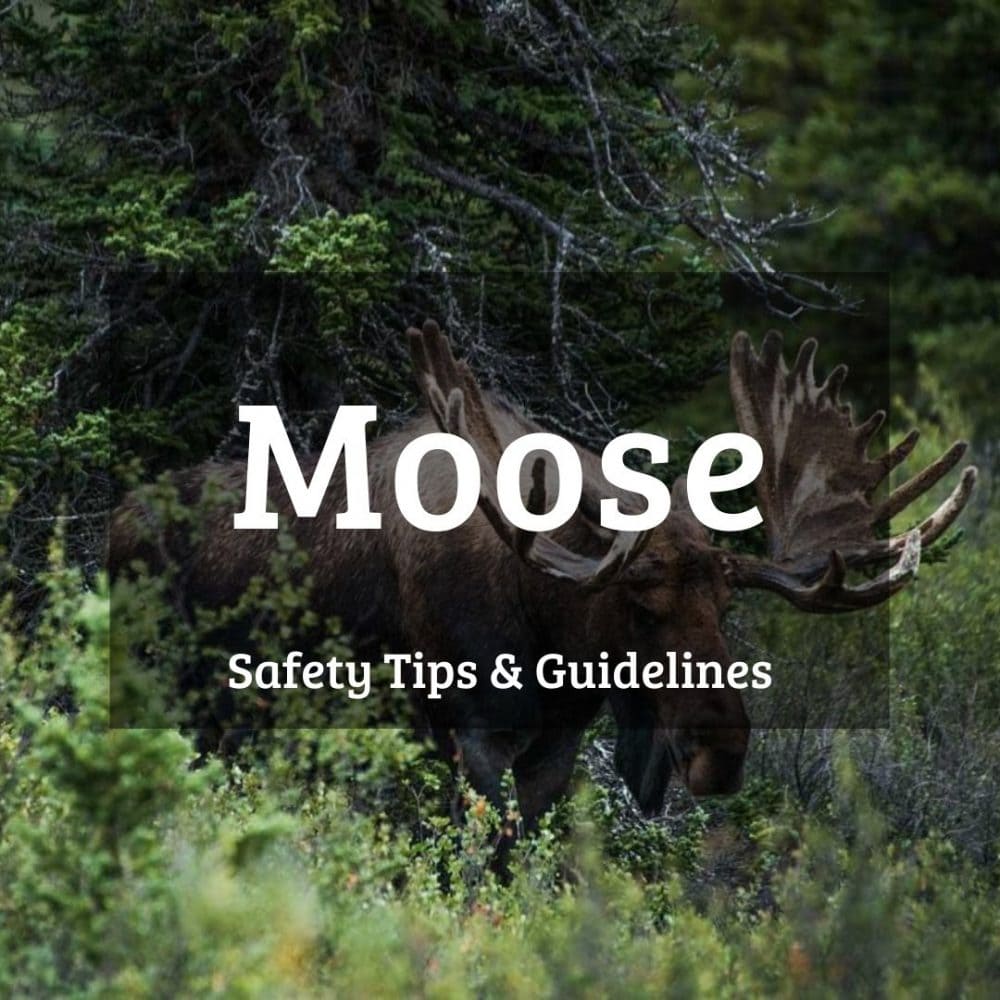Article Topics: Best Places to Visit in Yellowstone National Park, Where to Go in Yellowstone, Top Attractions in Yellowstone National Park
One of the largest national parks in the contiguous United States, Yellowstone is not a place you can fully explore and experience in a day or two. Some might even say it’s impossible to see it in a week, or even a month. Yellowstone National Park is enormous.
That said, though, knowing the best places to visit in Yellowstone will help you make the best of your time in the park, however long that may be.
In this post, I’ll take you on a long loop around Yellowstone National Park. We’ll take a look at each corner of the park, the top Yellowstone attractions, not-to-miss places in Yellowstone, as well as some suggested hikes.
Contents
- Main Areas of Yellowstone National Park
- 22 Essential Places to Visit in Yellowstone National Park
- 1. Mammoth Hot Springs
- 2. Tower-Roosevelt & Northern Range
- 3. Canyon Village
- 4. Yellowstone Lake
- 5. Old Faithful Village
- 6. Norris
- 10 Books to Read Before Your Visit to Yellowstone
- Wildlife Safety in Yellowstone National Park
Main Areas of Yellowstone National Park
Yellowstone National Park is so big—yes, I’m going to repeat that a few more times in this blog post—that it’s split up into different areas in three states: Montana, Idaho and Wyoming. The main areas in Yellowstone are the following, clockwise from the north:
- Mammoth Hot Springs – colorful hot springs, beautiful travertine terraces, desert-like canyons and hills
- Tower-Roosevelt & Northern Range – rugged mountain ranges, wide valleys and tons of wildlife
- Canyon Village – home to the spectacular Grand Canyon of the Yellowstone, while nearby Hayden Valley is rich in wildlife
- Yellowstone Lake – shoreline accommodations and services on massive Yellowstone Lake, along with a unique geyser basin
- Old Faithful Village – star attraction in Yellowstone, surrounded by hundreds of other hydrothermal features in several geyser basins
- Norris – hottest geyser basin in the park, plus a couple of great museums
You could easily spend half a day exploring each of these top places to visit in Yellowstone National Park.
In fact, you might need a full day or even more to really immerse yourself in some of them, especially the attraction-filled Old Faithful area, the diverse Mammoth region, or the sprawling Northeast of the park. To see all of them, you’ll need at least five days in Yellowstone.
This post about the best places to visit in Yellowstone National Park contains affiliate links. You can read more about our Terms of Use / Disclosure here.
22 Essential Places to Visit in Yellowstone National Park
Planning a Yellowstone National Park vacation and figuring out what are the best things to do in Yellowstone can be overwhelming. Before our first visit to Yellowstone, I spent literally weeks reading national park books and blogs, watching documentaries and listening to podcasts myself.
While I’m aware that the sheer number of Yellowstone highlights may make it difficult to decide what to focus on, I also know that, once you’re there, things tend to be much easier. Simply put, inside the park, you just drive from one main area to the next.
It is essential, however, to have some kind of plan or itinerary in place. Not to mention the need to book accommodation or campsites way in advance, at least half a year before your trip.
So, to help you figure out where to go and what to do in Yellowstone National Park, I’ll discuss each of those six main Yellowstone areas, with their top attractions and activities, separately.
We’ll start in the far north at Mammoth Hot Springs and work our way around the park in a clockwise direction. Let’s go!
1. Mammoth Hot Springs
Mammoth Hot Springs Terraces
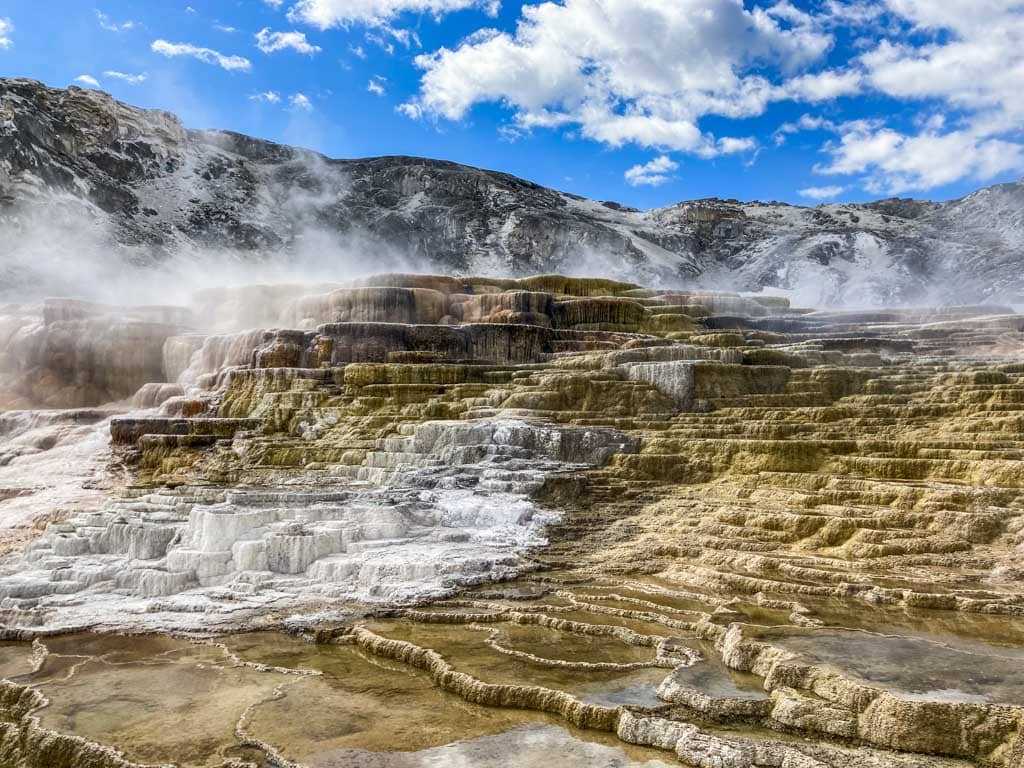
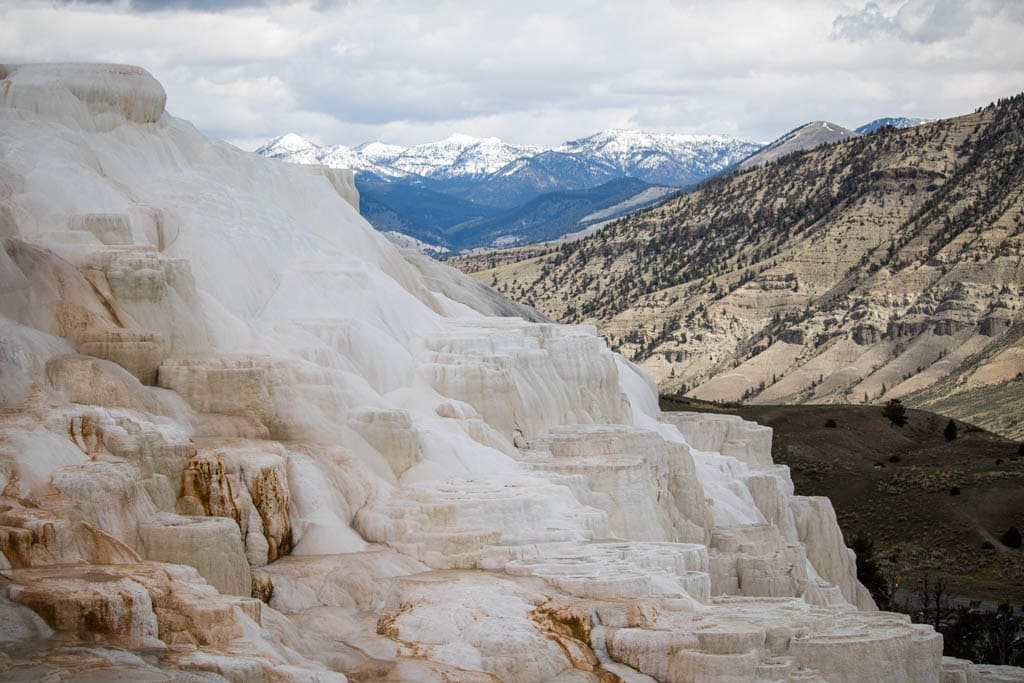
One of the absolute top things to do in Yellowstone National Park is a walk on the Mammoth Hot Springs boardwalks.
One of the park’s many, and among its most extraordinary, hydrothermal areas, Mammoth Hot Springs is a stunning collection of travertine terraces, the result of limestone deposited by hot springs.
In fact, travertine builds up so quickly here, while hot springs dry up and come back to life sometimes overnight, that this is among Yellowstone’s fastest-changing areas. Mammoth Hot Springs literally looks different each year.
So-called thermophiles—heat-loving bacteria—add a wide range of color to the bright chalk-white travertine, creating a magnificent natural wonder.
A network of boardwalks and stairways runs through the Lower Terraces, allowing you to see marvelous geothermal features like Palette Spring, Minerva Terrace and Cleopatra Terrace from up close.
Liberty Cap, at the base of the Lower Terraces, is a solidified 37-foot former hot spring cone. At the top of the Lower Terraces, Canary Spring is a gorgeous white-and-orange hot spring, arguably the most beautiful feature in this particular area.
The Upper Terraces can be explored on the 1-mile Upper Terrace Drive, a one-way drive that’s usually open between mid-May and November.
Fort Yellowstone
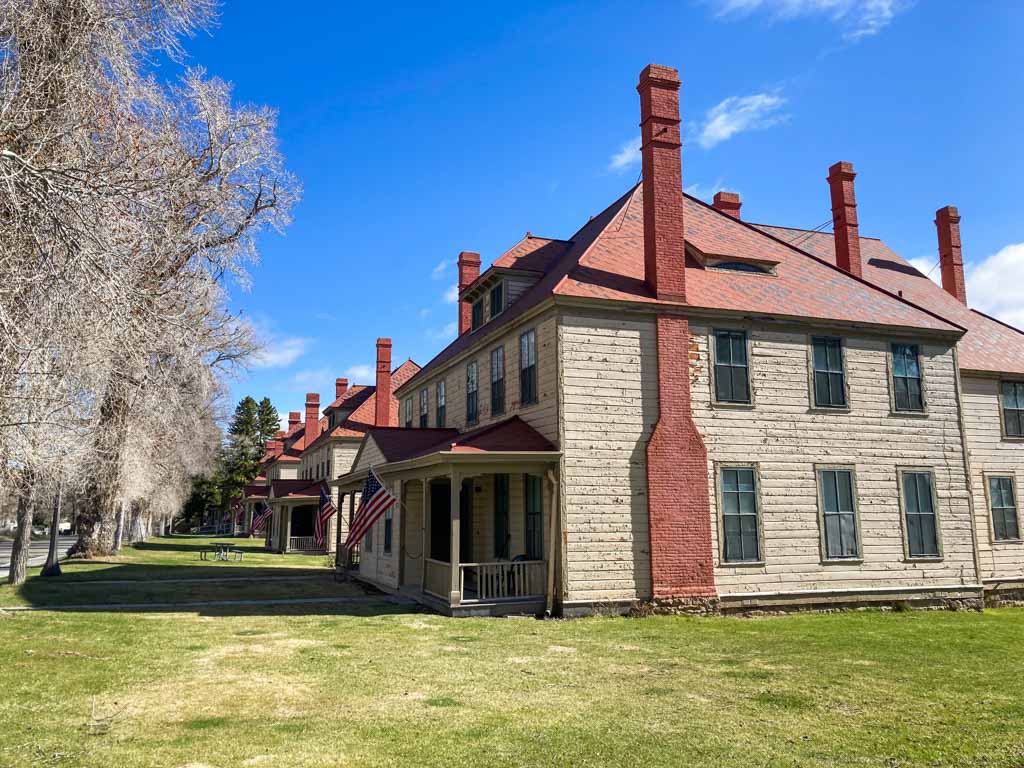
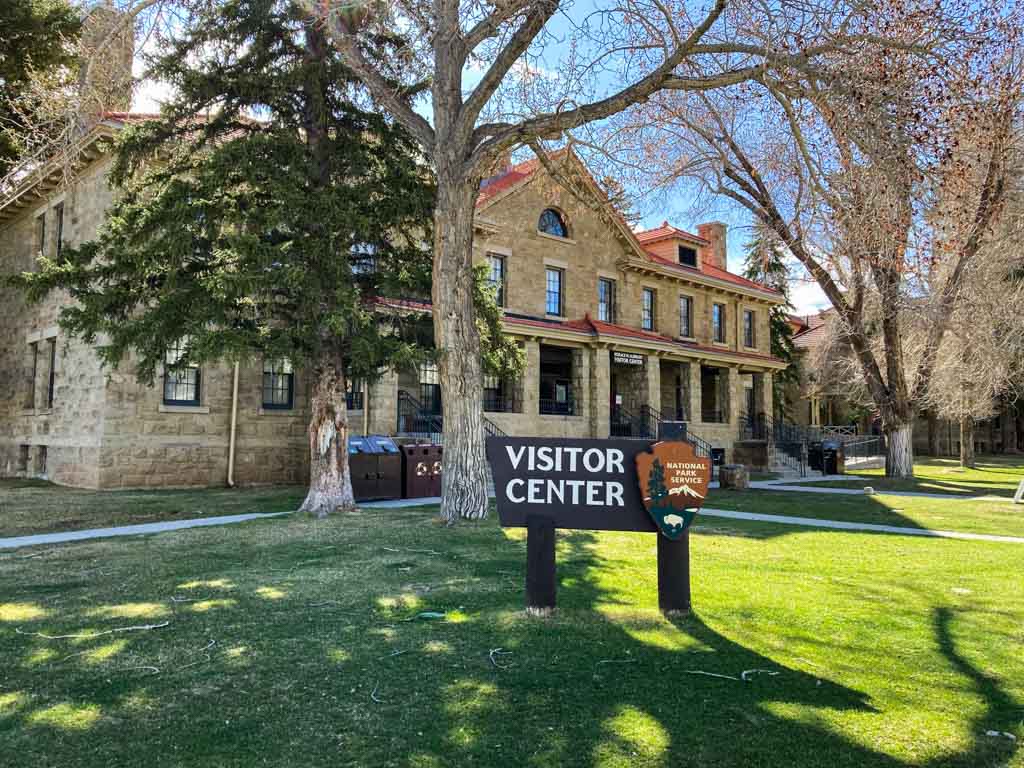
After the U.S. Congress created Yellowstone National Park in 1872, making it the world’s very first national park, it lacked virtually any form of management or supervision. Poachers, looters and all kinds of other dubious people exploited the park undisturbedly for over a decade.
Then, in 1886, the U.S. Army was deployed to Yellowstone to help. Soldiers set up camp at Mammoth Hot Springs, which is still the park’s headquarters today, and effectively created the job of park ranger.
Instead of fighting wars abroad, they received park visitors, managed wildlife, conducted search-and-rescue operations and, generally, kept an eye on things in Yellowstone.
Until the creation of the National Park Service in 1916, the U.S. Army soldiers were based at Fort Yellowstone, a collection of barracks, officers’ houses and official buildings.
A self-guided walking tour takes you around Fort Yellowstone and is one of the top things to do at Mammoth Hot Springs.
The tour starts at the Albright Visitor Center, which is just across the road from Mammoth Hot Springs Hotel. This is one of the best places to visit in Yellowstone to learn about the park’s rich history.
Roosevelt Arch
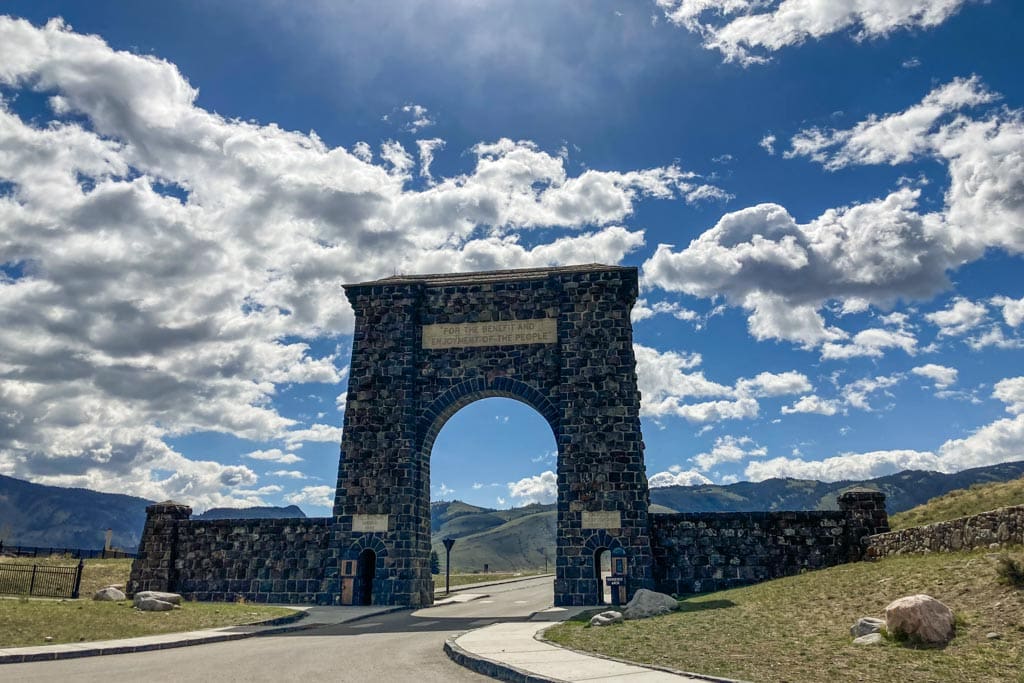
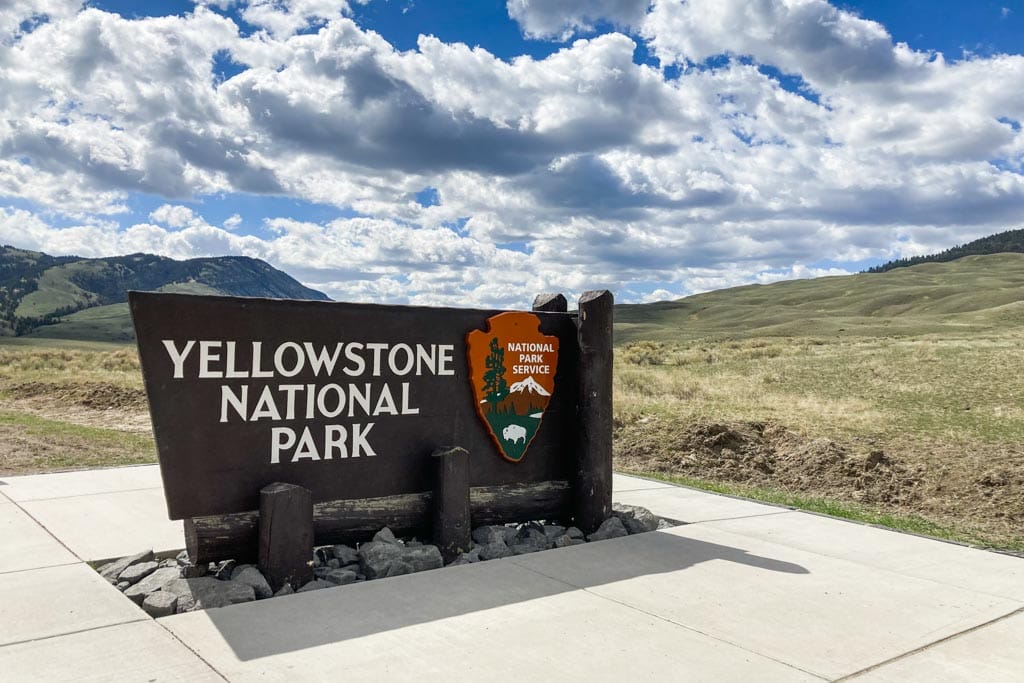
The original, and once the only, road into Yellowstone National Park runs through the Roosevelt Arch in Gardiner, Montana.
Dating from 1903, this huge stone arch is a major symbol of the national park system. The engraving near the top says “For the benefit and enjoyment of the people”, a direct quote from the National Park Service Organic Act of 1916.
The arch is dedicated to President Theodore Roosevelt, one of America’s most influential conservationists.
You can still drive through the Roosevelt Arch, while you can also park your vehicle and explore Arch Park on foot. There’s a large “Yellowstone National Park” sign behind the arch, a popular photo spot. Additionally, you can usually see elk grazing in the meadows around the arch; bison are regularly seen here, too.
Open only in summer, the unpaved Old Gardiner Road connects Mammoth Hot Springs and Gardiner. It is a popular two-way mountain biking road, while 4WD vehicles can drive it one-way to the north.
2. Tower-Roosevelt & Northern Range
Blacktail Plateau
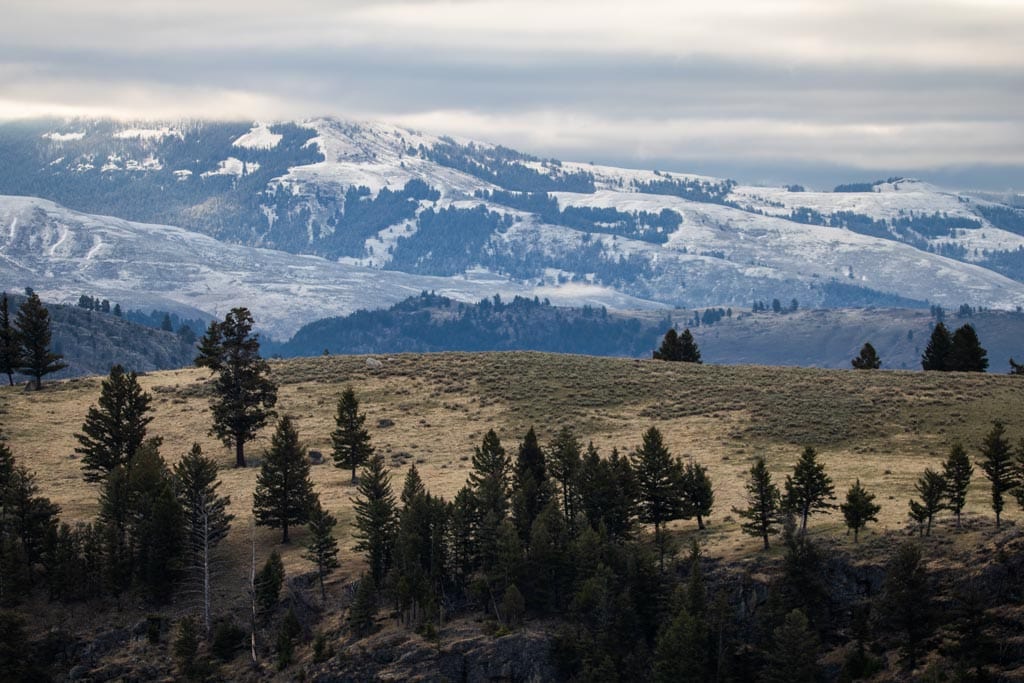
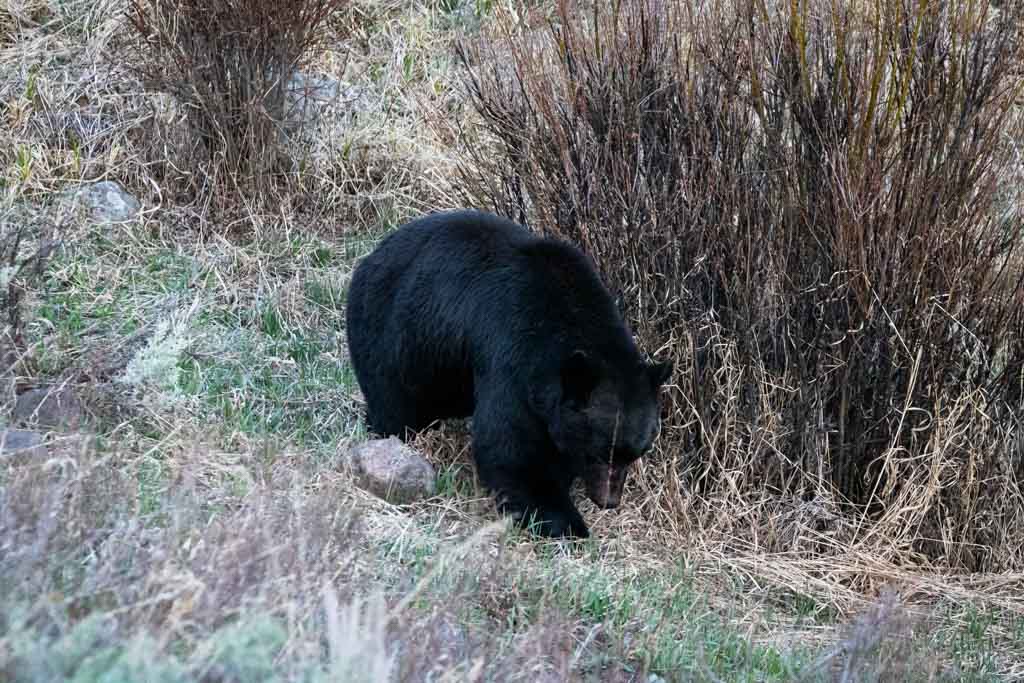
Bisected by the Mammoth-Tower Road, Blacktail Plateau is a vast region you drive through on the way from, well, Mammoth to Tower-Roosevelt. You won’t find this area featured in many typical guidebooks that cover the national parks, but I personally love it.
Blacktail Plateau is much more than a drive-through area. It’s a massive highland with snowcapped mountains, expansive meadows, mysterious pine forests, reflective ponds, waterfalls and—do I have to say it?—lots of wildlife.
We’ve seen both black and grizzly bears here, along with lots of elk, pronghorn, marmots, bighorn sheep and deer.
Just west of Mammoth, you can enjoy a view of Undine Falls. Hikers can hit the short 1-mile roundtrip trail to Wraith Falls.
Just over halfway between Mammoth and Tower-Roosevelt, the 6-mile one-way Blacktail Plateau Drive offers the opportunity for a fun detour through alpine meadows and woodlands. Wildlife is abundant in this particular area. This scenic unpaved drive is open only in summer—in spring, it’s closed for bear management.
Lamar Valley
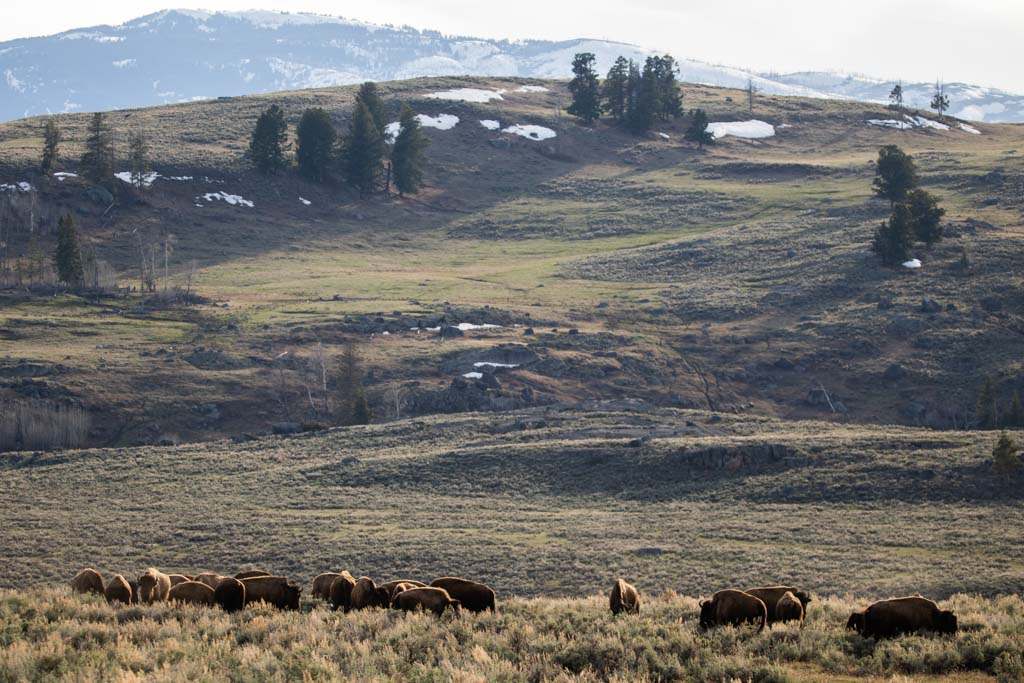
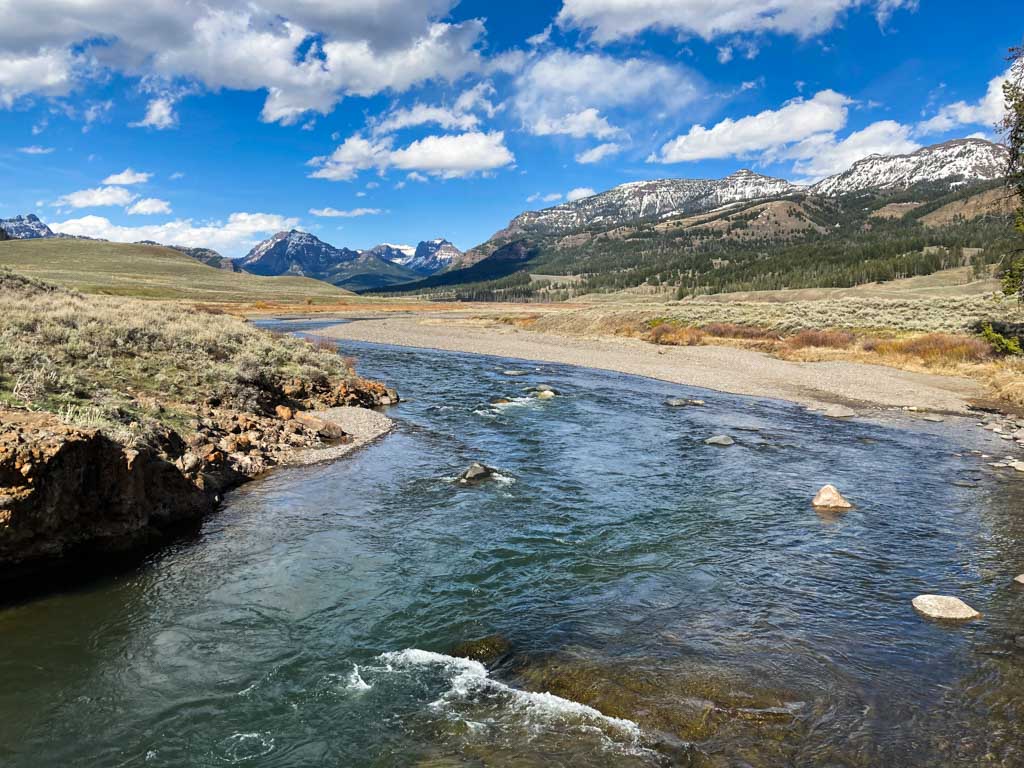
Located in the remote northeastern part of Yellowstone National Park, the sprawling Lamar Valley offers one of the very best Yellowstone experiences: world-class wildlife watching. Driving through and spotting animals in the Lamar Valley is easily one of the best things to do in Yellowstone National Park.
The Lamar River cuts through this vast valley, its relatively low elevation making it a preferred wintering range for immense herds of elk and bison. In fact, this is where you’ll find some of North America’s largest bison herds.
If you want to see bison in Yellowstone National Park, this is unquestionably one of the best places to go, if not the best. Bison are present in the Lamar year-round.
In this sagebrush-covered valley, you can also see bighorn sheep and pronghorn (the fastest land animal on the continent). No wonder this region is often called the “American Serengeti.”
The sheer abundance of prey animals attracts large numbers of predators to the Lamar Valley, too. Both black and grizzly bears are common sights, while coyotes, foxes and even mountain lions live here as well. But arguably the most exciting wildlife sightings in the Lamar Valley are its wolf packs.
This is without a doubt the best place on the planet to see wolves in the wild. Several packs call the Lamar Valley home, occasionally seen from roadside pullouts. Individual wolves may get closer to the road, like the one single black wolf we saw wandering near the western end of the valley.
For the best chances to see a variety of wildlife in the Lamar Valley, one of my favorite Yellowstone activities, go there at dawn or dusk.
Tower Fall
One of the most famous waterfalls in Yellowstone National Park, Tower Fall plunges 132 feet between volcanic rock formations.
This beautiful waterfall has inspired visitors and artists alike ever since Euro-Americans began exploring the region. That included Thomas Moran, whose painting of Tower Falls, along with others of his works, contributed to the establishment of Yellowstone National Park in 1872.
You can see Tower Fall from an overlook a short stroll from the Tower General Store.
3. Canyon Village
Grand Canyon of the Yellowstone
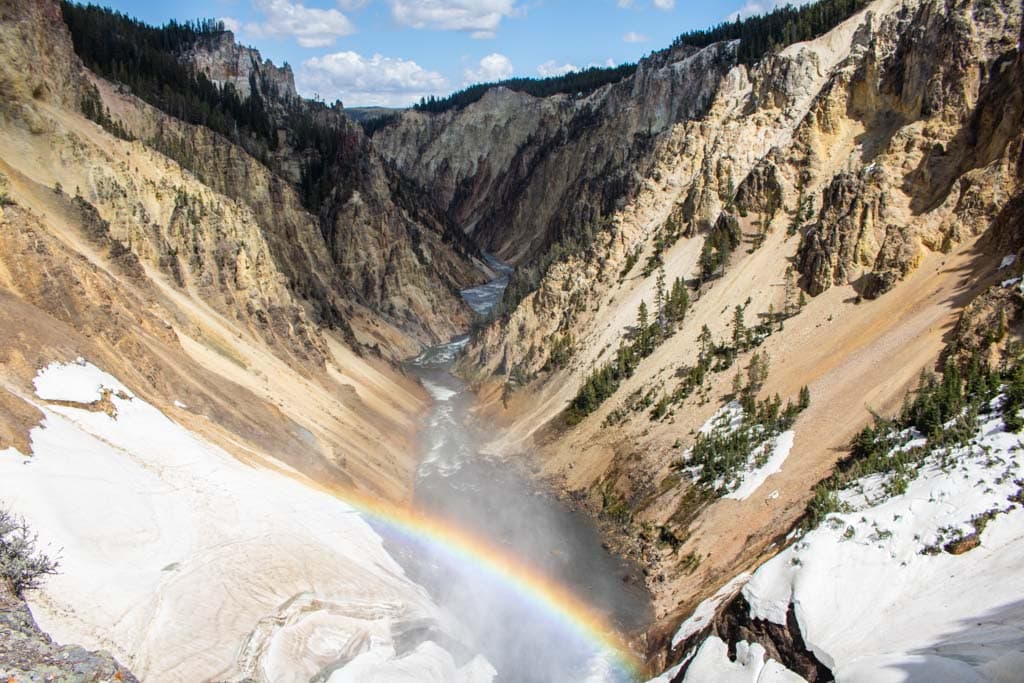
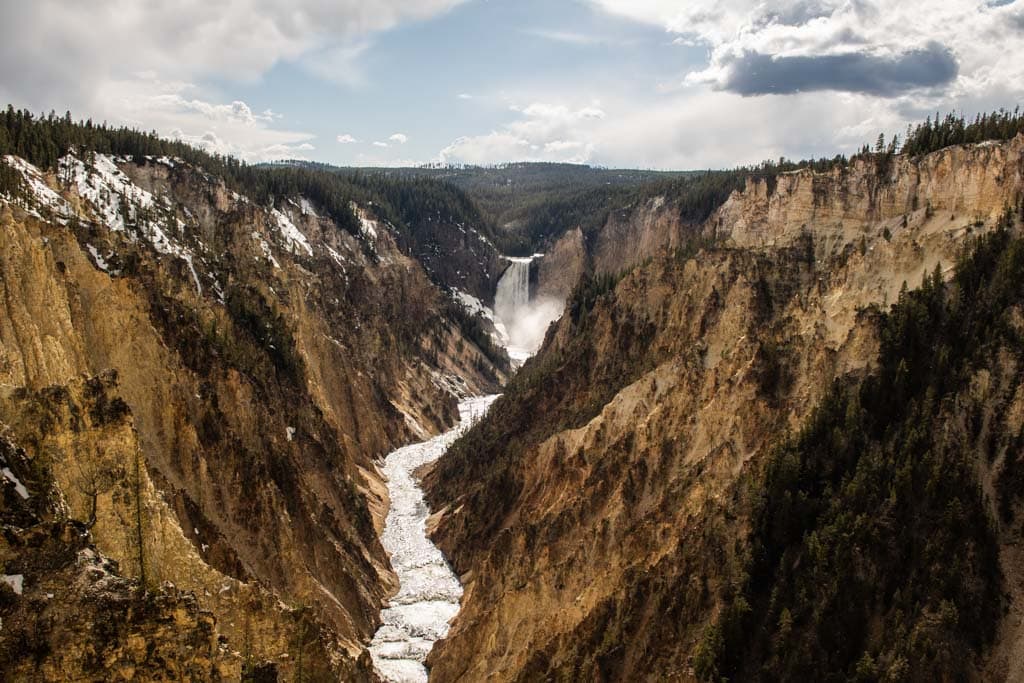
If a wealth of wildlife and gigantic geysers weren’t enough, Yellowstone National Park also has its very own Grand Canyon. A breathtaking river chasm, the Grand Canyon of the Yellowstone is one of the most spectacular places to visit in Yellowstone National Park.
This is the park’s second-busiest area, after Old Faithful, and it’s not hard to see why. The canyon is 20 miles long, over 1,000 feet deep and up to 4,000 feet wide, featuring multi-colored rock layers, formations and even cliffside fumaroles.
You can admire the dramatic shapes and colors of Yellowstone’s Grand Canyon from the North and South Rims. Both rims have their own Rim Drive, hiking trails and overlooks, all offering (slightly) different vantage points.
My favorite viewpoints on the North Rim are Lookout Point, Inspiration Point and, especially, the Brink of the Lower Falls, accessed via a steep trail down to the top of the 308-foot Lower Falls, which is twice as high as Niagara Falls.
On the South Rim, nothing compares to the panoramic view from Artist Point, one of the most famous views in America’s national parks.
There, the scene resembles that of Thomas Moran’s iconic oil painting of the canyon, which he declared to be so beautiful it is “beyond the reach of human art.” Uncle Tom’s Trail is a strenuous descent including 300+ stairs down to the foot of the Lower Falls.
Hayden Valley
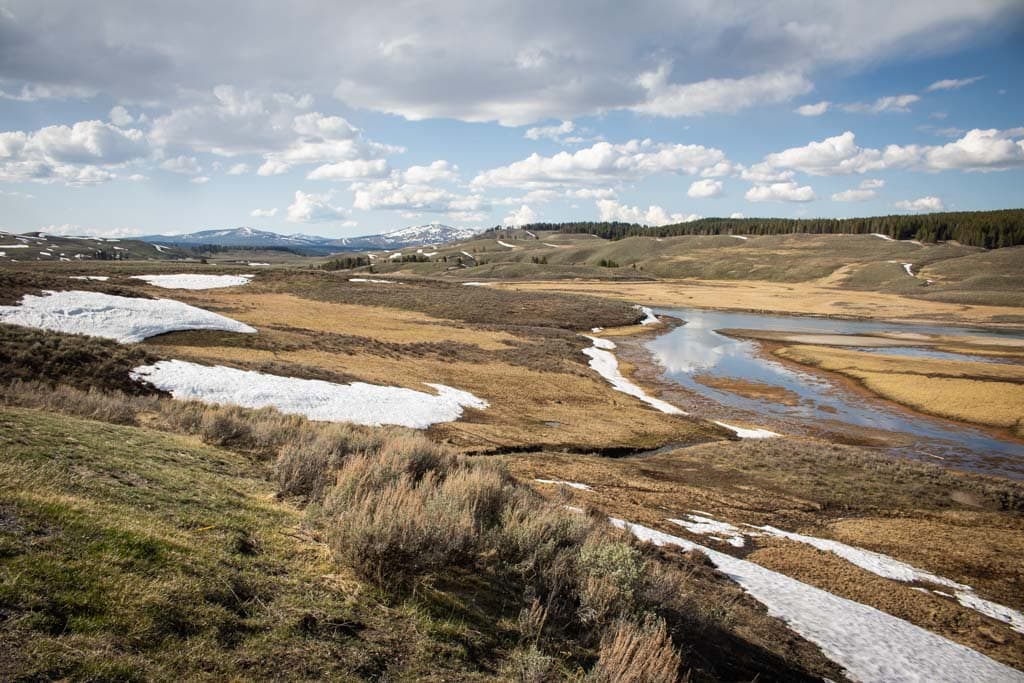
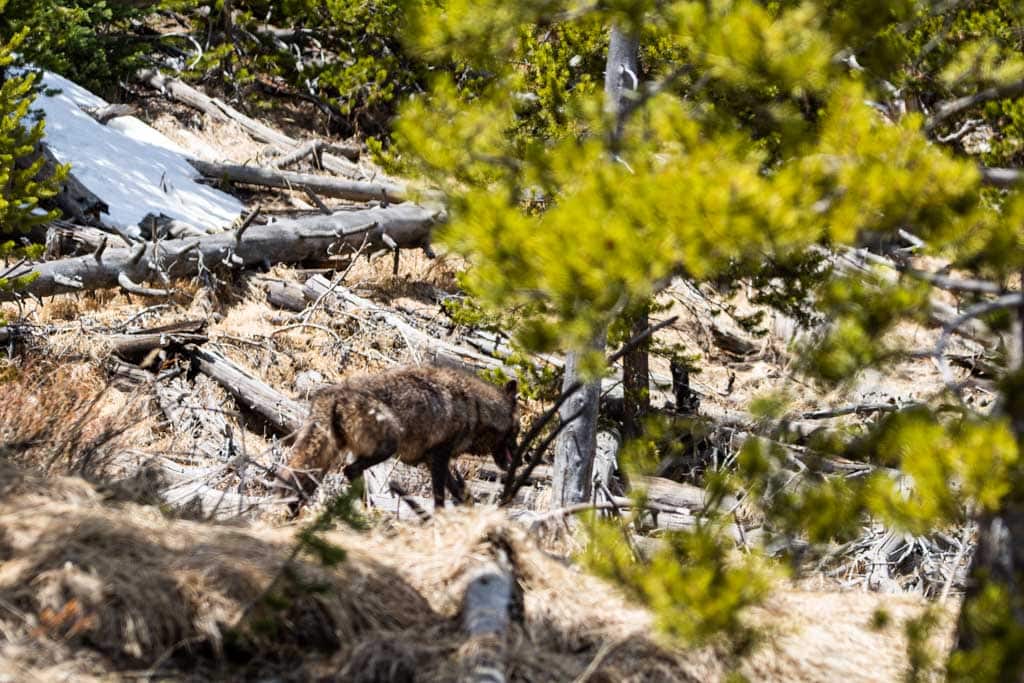
Smaller than the Lamar Valley, yet no less filled with wildlife, Hayden Valley is just south of the Grand Canyon of the Yellowstone.
Once part of Yellowstone Lake, this picturesque valley is sliced in half by the Yellowstone River, its plains and ponds home to bison, elk, moose, swans, cranes, pelicans and geese.
This is one of the best places to visit in Yellowstone National Park for wildlife. Although animals abound here throughout the entire year, your viewing opportunities are best in summer.
From June through August, spend an afternoon here to see the above-mentioned elk and bison, but also grizzly bears and wolves. In August, bison from all over the region gather in Hayden Valley for the annual rut, the breeding season, a spectacle you should not miss in Yellowstone.
In spring, sightings can be hit or miss, though. During our time in Hayden Valley—we drove through three times at different times of the day—we didn’t spot a single bison, but we did see tons of birds, a lone wolf and several elk.
Mud Volcano
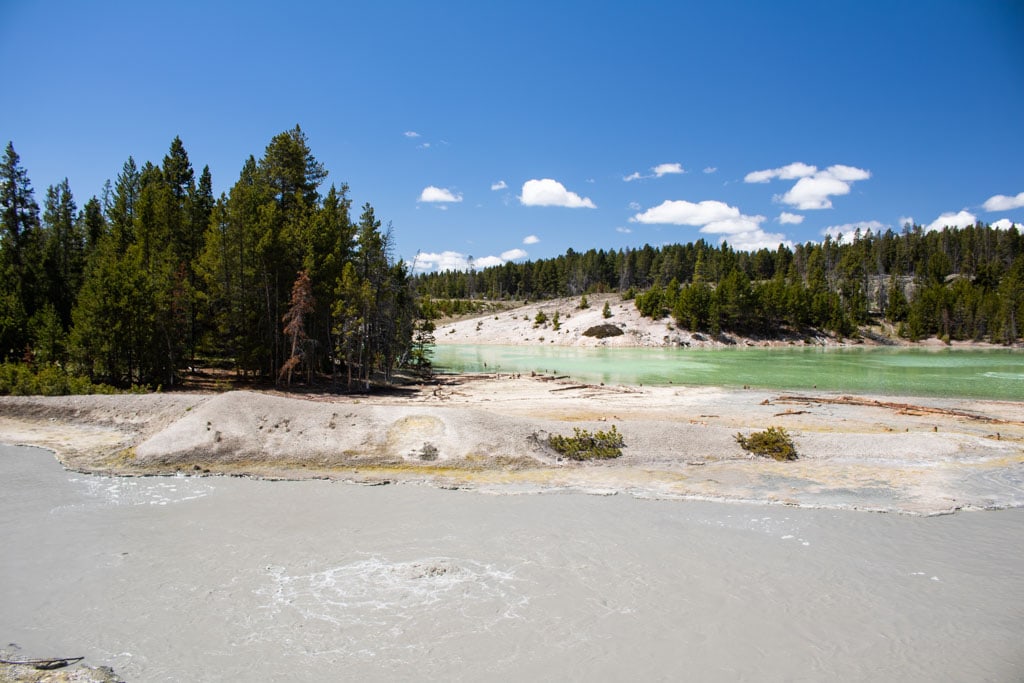
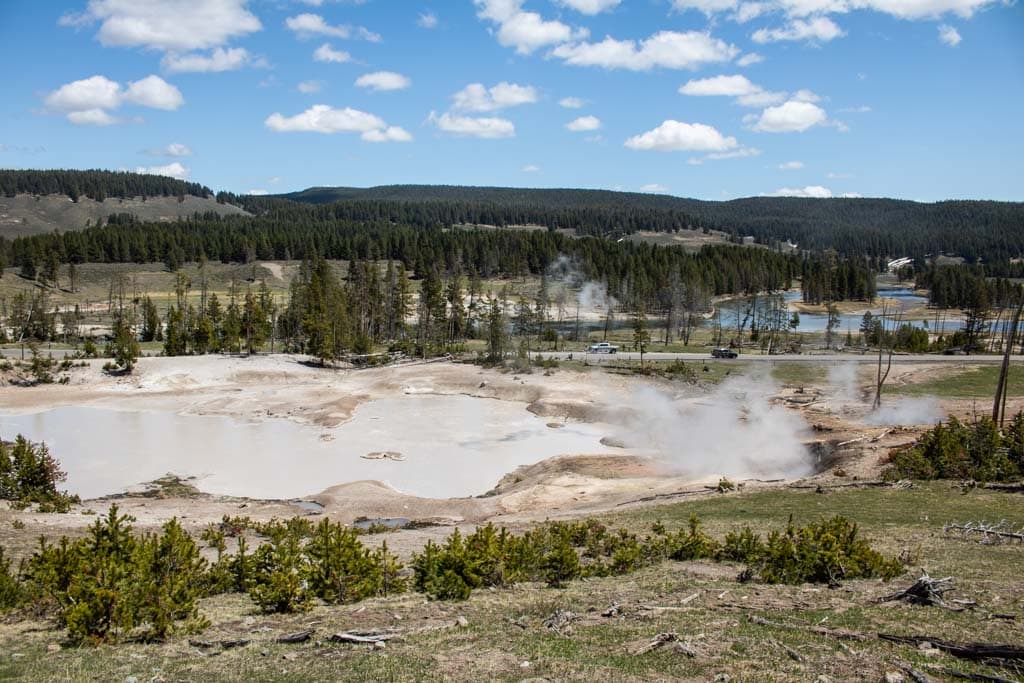
A remarkable hydrothermal area on the southern edge of Hayden Valley, the Mud Volcano Area is dotted with fumaroles and mud pots, such as the one and only Mud Geyser, whose cone once towered 30 feet high.
A boardwalk loop takes you through this fascinating place, where a smell of sulfur greets you as soon as you get out of your car.
Spend an hour or so exploring the many features, including such extraordinary ones as the acid-green Sour Lake, the roaring Dragon’s Mouth Spring and the astonishing Churning Caldron, which violently roils, sloshes and steams.
4. Yellowstone Lake
Fishing Bridge
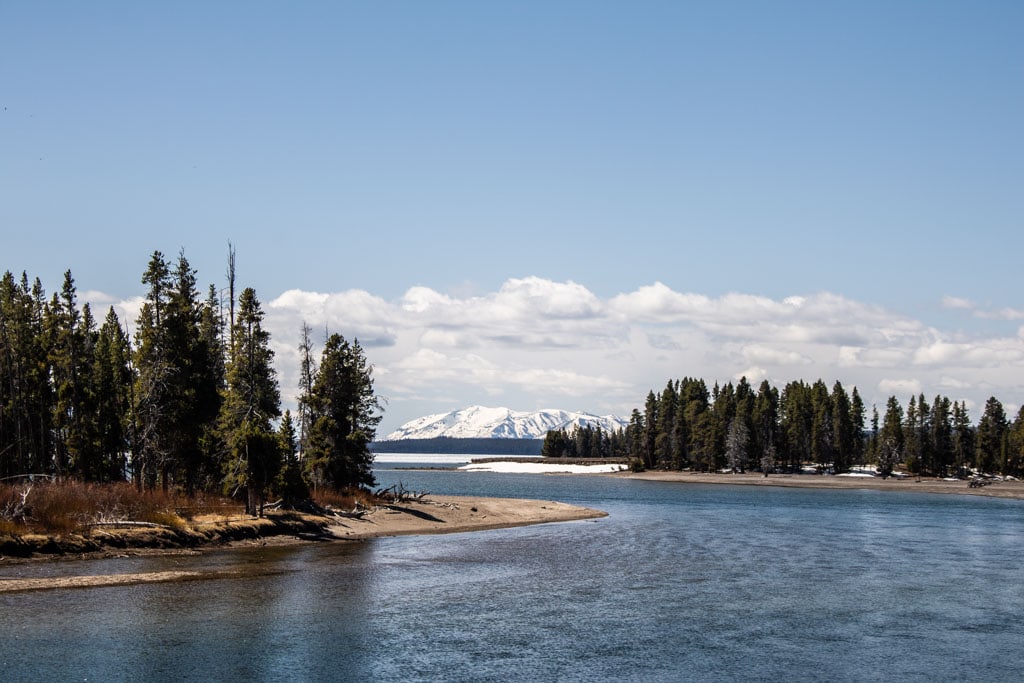
The Yellowstone River flows north out of Yellowstone Lake at Fishing Bridge on its way to the Grand Canyon. As its name suggests, the bridge across the river offers excellent fishing. It was such a popular spot among anglers, in fact, that way too many fish were caught here in the 1960’s and 70’s.
The National Park Service closed the entire area to fishing in 1973 to protect these important cutthroat trout spawning grounds. Nowadays, walkways on both sides of Fishing Bridge provide you with the chance to see these native fish battle the current below.
Additionally, in summer, this is a great place to see grizzly bears, who love trout just as much as the fishermen used to.
Consider swinging by the nearby Fishing Bridge Visitor Center, too. This stone-and-log building was a prototype of park buildings across the country—a prime example of what is now known as “parkitecture.”
Inside, you can see a plethora of mounted wildlife, especially birds, including now-protected bald eagles and trumpeter swans.
Lake Yellowstone Hotel
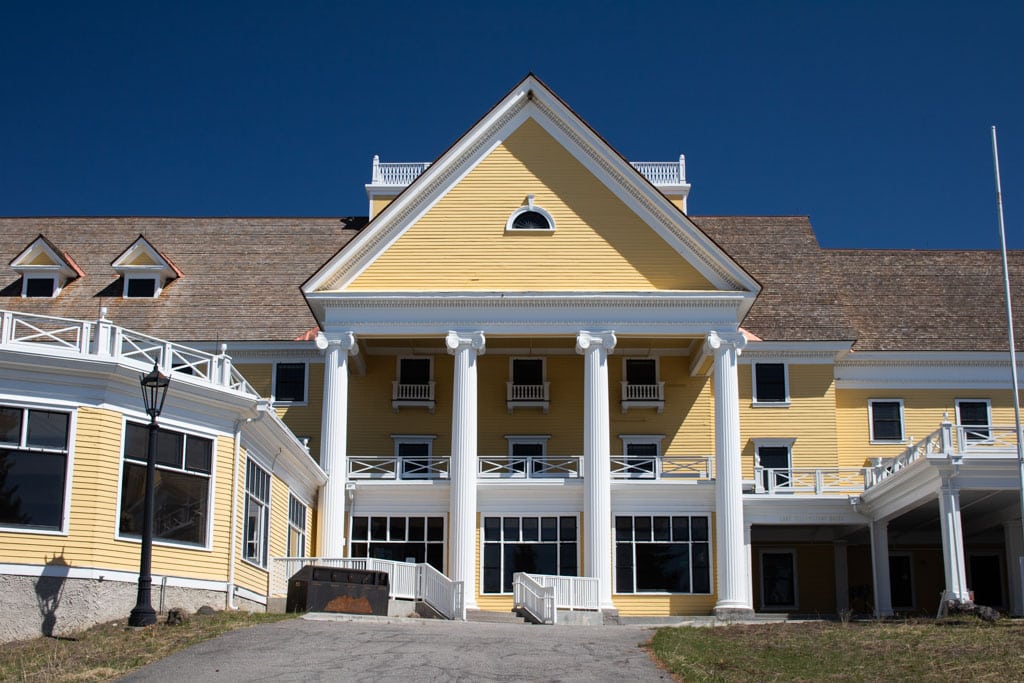
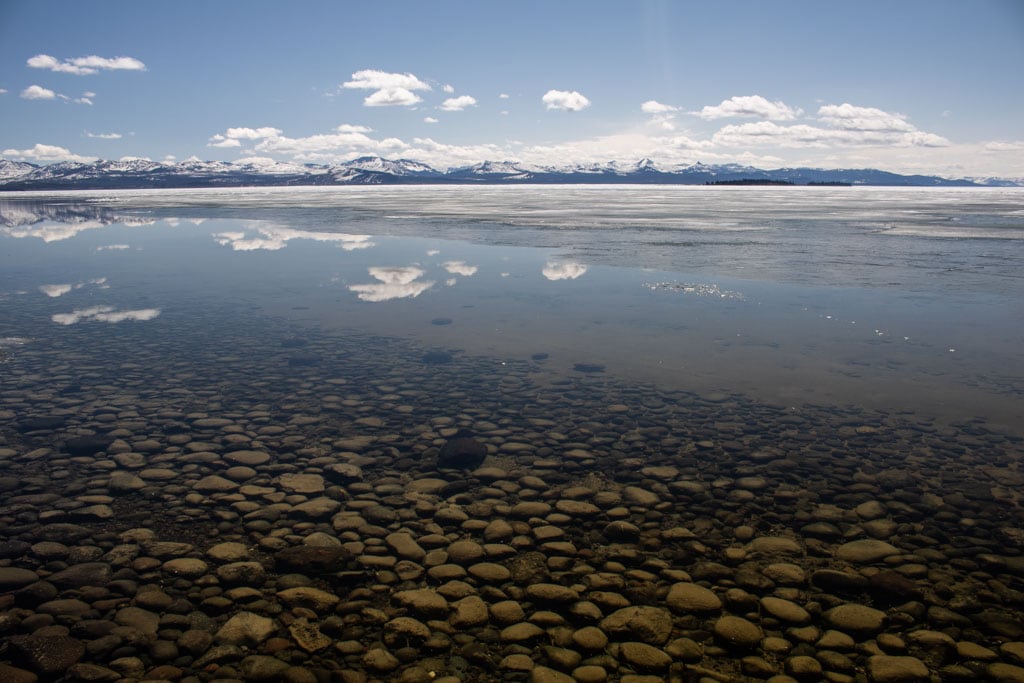
You don’t necessarily have to stay there, but I do recommend at least visiting the Lake Yellowstone Hotel. If you’re into history, you might be interested in the fact this is the oldest lodge in the park.
Dating from the 1890’s, the Lake Yellowstone Hotel has welcomed visitors for more than 125 years. Its striking white columns and yellow exterior provide colonial-style elegance and sophistication, while its rooms are cozier than ever.
Walk around Lake Village and enjoy some wonderful views of Yellowstone Lake, the largest alpine lake in North America. You can grab breakfast, lunch or an afternoon drink at the general store, deli or cafeteria.
West Thumb Geyser Basin
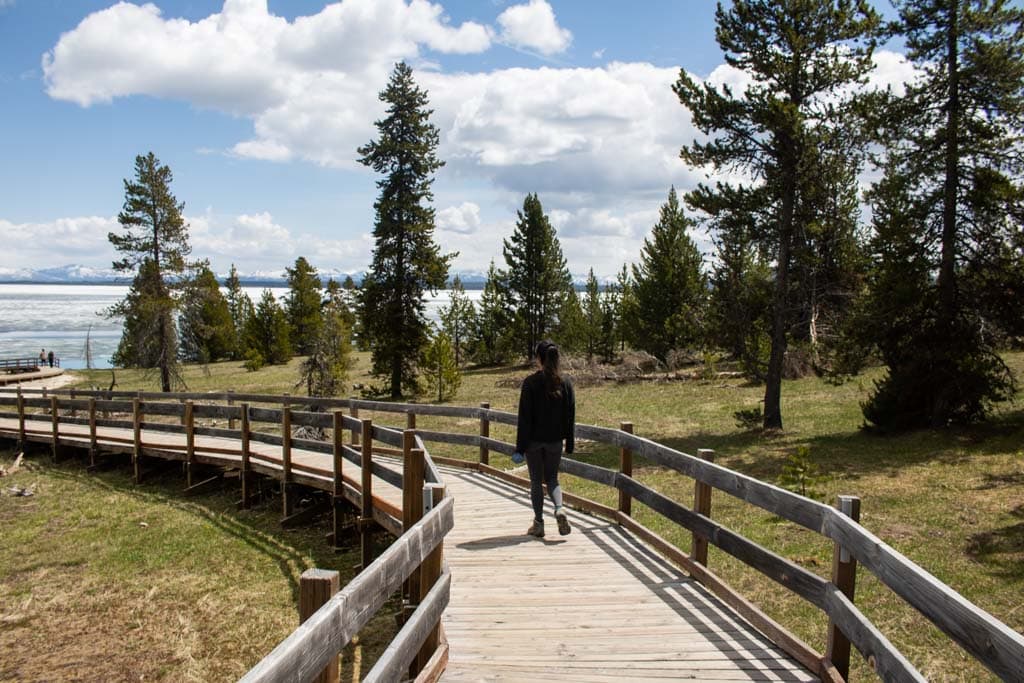
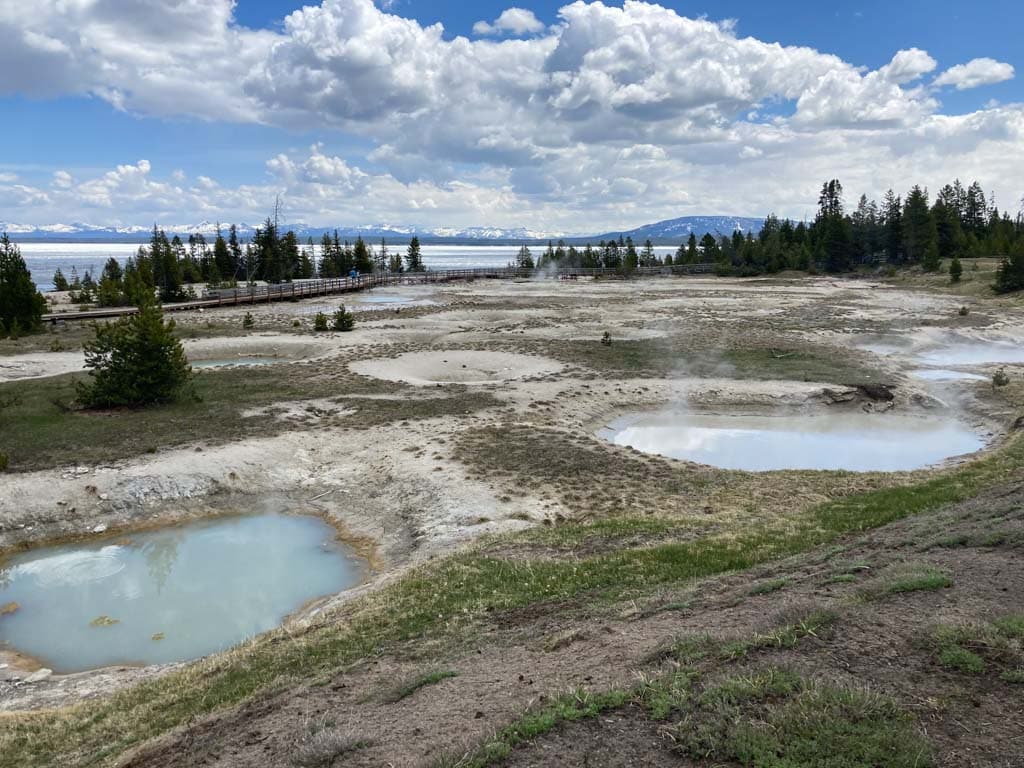
Situated on the far western shore of Yellowstone Lake, the West Thumb Geyser Basin is one of the top things to see in Yellowstone National Park. One of the park’s seven thermal areas, it is in the heart of the gigantic Yellowstone Caldera.
The West Thumb of Yellowstone Lake is actually a caldera within a caldera, formed about 174,000 years ago. That eruption created a depression, which later filled with water and formed a huge bay in the west of the lake.
At the West Thumb Geyser Basin, a figure-8 boardwalk double loops throughout a lakeshore basin dotted with three geysers and almost a dozen mud pots.
Fishing Cone is one of the top attractions at Yellowstone Lake, a geyser where locals and visitors alike used to cook freshly caught fish. Other highlights at West Thumb include Black Pool and Abyss Pool, one of the deepest hot springs in Yellowstone National Park.
When exploring the West Thumb Geyser Basin, keep an eye out for elk and moose, the occasional grizzly, and pelicans and trumpeter swans on the lake.
5. Old Faithful Village
Old Faithful
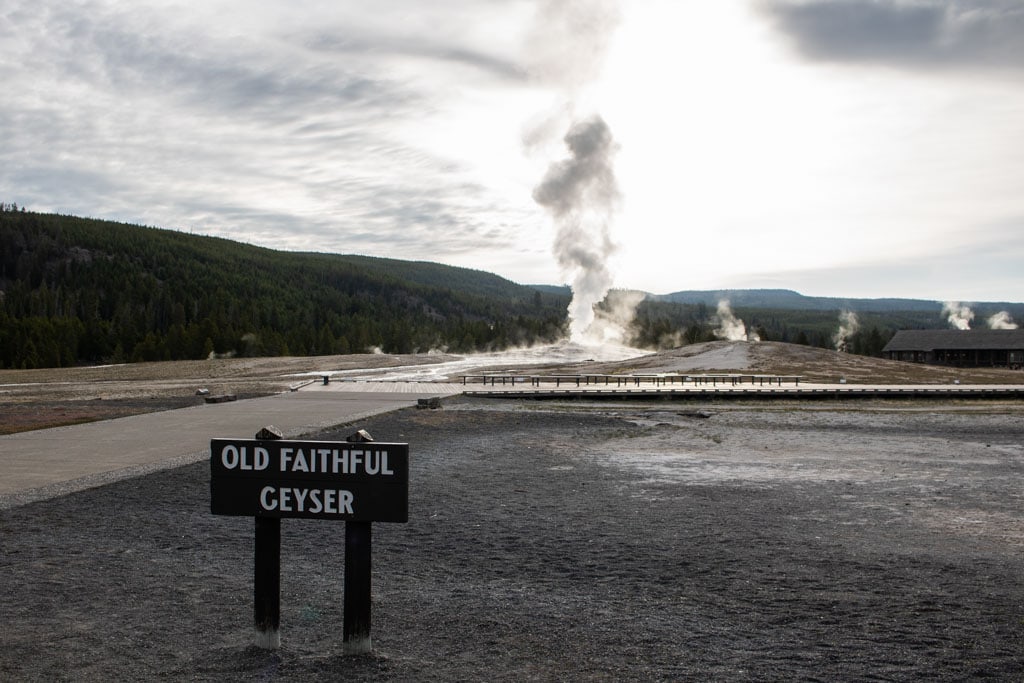
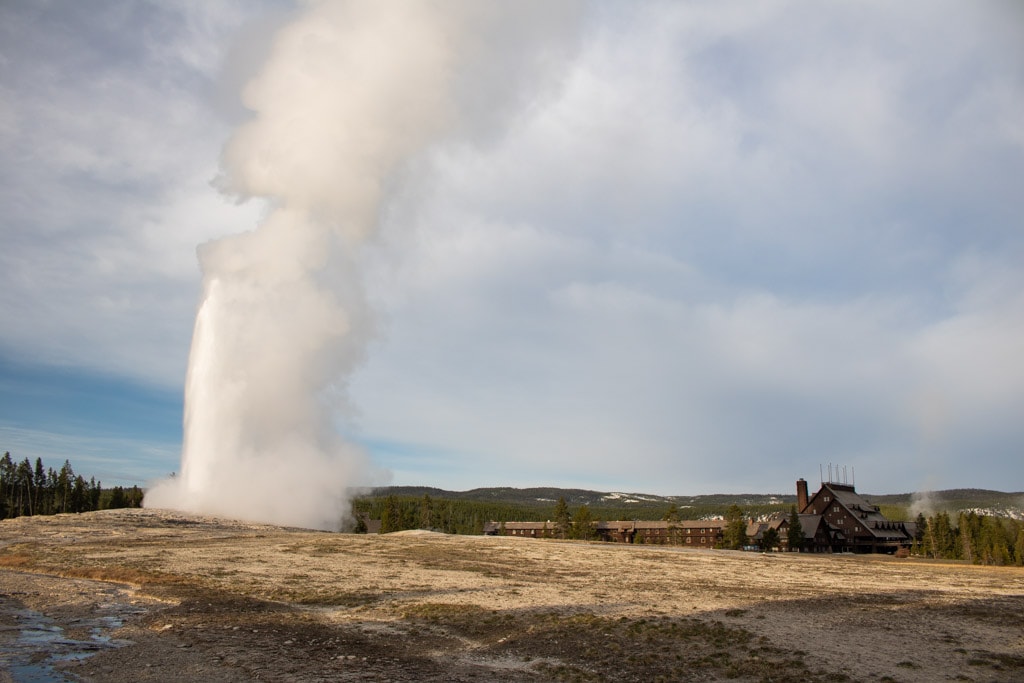
The world’s most famous geyser doesn’t need an introduction. The most-visited attraction in Yellowstone National Park, Old Faithful draws in enormous daytime crowds in the summer season.
Although this is neither the largest nor the most frequently erupting geyser in Yellowstone, it does do its name justice. Old Faithful erupts, well, faithfully every 90 minutes or so, with bursts of steaming water shooting up to 185 feet into the sky.
Watching Old Faithful erupt is absolutely one of the top things to see in Yellowstone National Park, but I’d strongly recommend avoiding the area in the middle of the day. It gets extremely, almost annoyingly, busy there.
Instead, get up early to enjoy an Old Faithful eruption around sunrise. If you’re not completely by yourself, there’ll only be a few other people around that early in the day, mainly photographers doing their thing.
Trust me when I say that viewing a sunrise eruption all by yourself is unforgettable.
Remember that this celebrity geyser erupts several times a day. You really don’t need to watch it at, say, 2 pm surrounded by a thousand—literally—other people. Do yourself a favor and enjoy Old Faithful at sunrise, before the hordes of tourists are awake.
You can watch Old Faithful erupt from the benches surrounding the geyser, but also with a drink—whether it’s a coffee or cocktail—in your hand from the sundeck at the Old Faithful Inn.
There’s also a short trail that leads up to Observation Point, offering a wonderful vantage point overlooking Old Faithful and the Old Faithful Inn.
Upper Geyser Basin
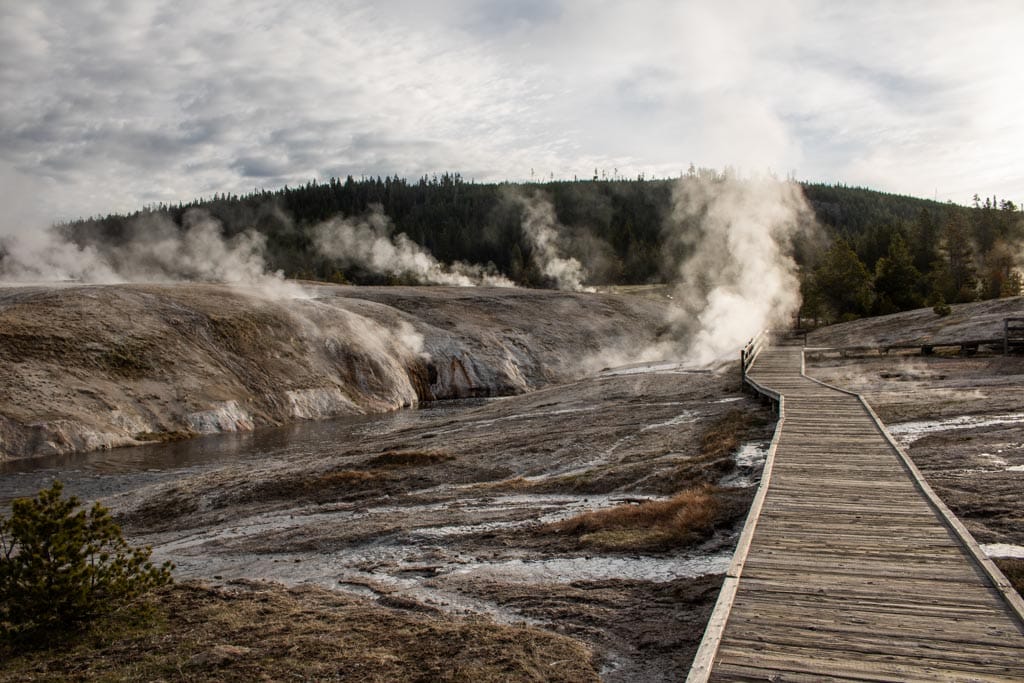
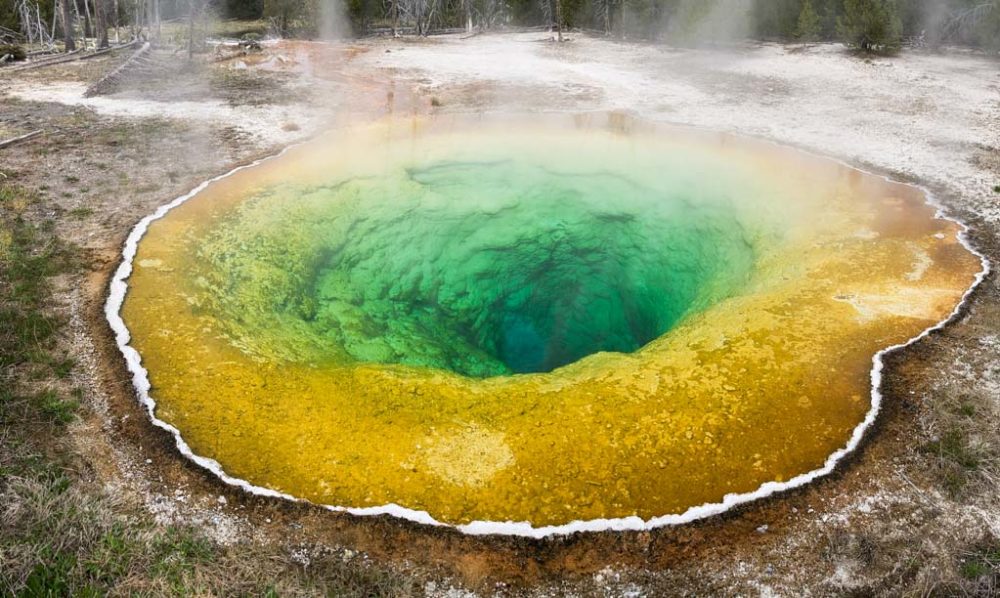
While Old Faithful is the undisputed star of the show, the Upper Geyser Basin is home to numerous other hydrothermal features, from hot springs and mud pots to fumaroles and dozens of other geysers.
In fact, this relatively small area encompasses the largest concentration of geysers in the entire world. Let’s put that in actual numbers, shall we? In this one-square-mile area, there are no fewer than 150 geysers. Of those 150+ geysers, only five can be predicted with relative regularity.
- Old Faithful Geyser
- Castle Geyser
- Grand Geyser
- Daisy Geyser
- Riverside Geyser
Check the National Park Service website for geyser eruption prediction in the Upper Geyser Basin.
Other geysers that erupt fairly regularly, although cannot reliably be predicted, include the remarkable Grotto Geyser and popular Beehive Geyser. To see all major geysers in the Upper Geyser Basin erupt, you’ll need to spend at least two days there.
A fun network of boardwalks and trails loops around and zigzags across the Upper Geyser Basin, allowing you to see many of the area’s many highlights from up close.
A popular hike is the circuit that starts at Old Faithful and ends at the stunning Morning Glory Pool, one of the most beautiful hot springs in Yellowstone. On the way, the trail runs along both geyser-lined banks of the Firehole River.
Old Faithful Inn & Lodge
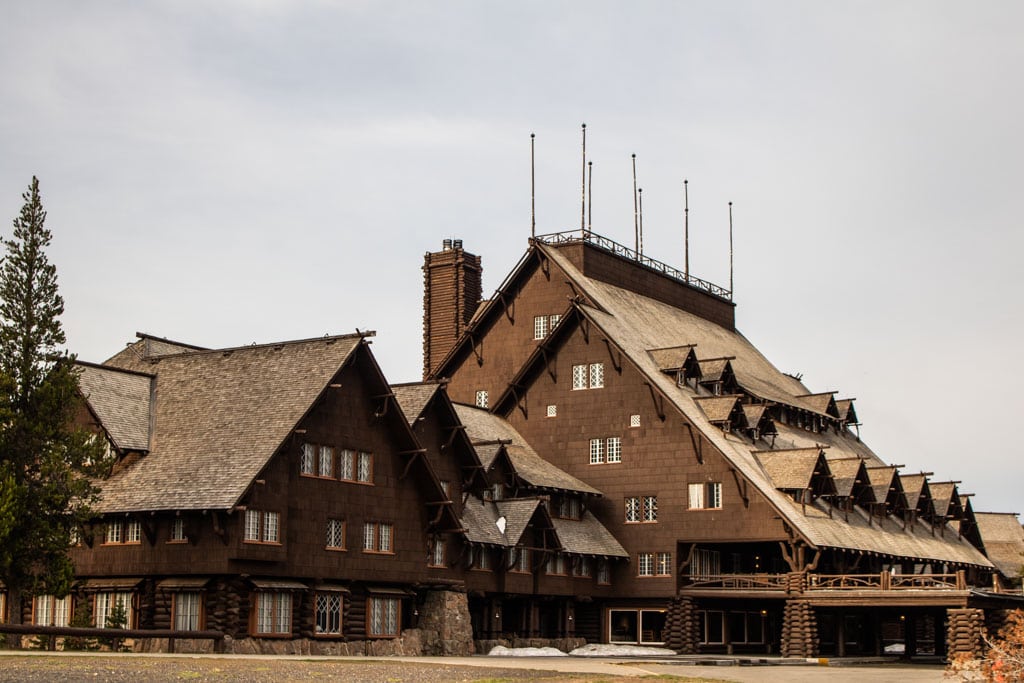
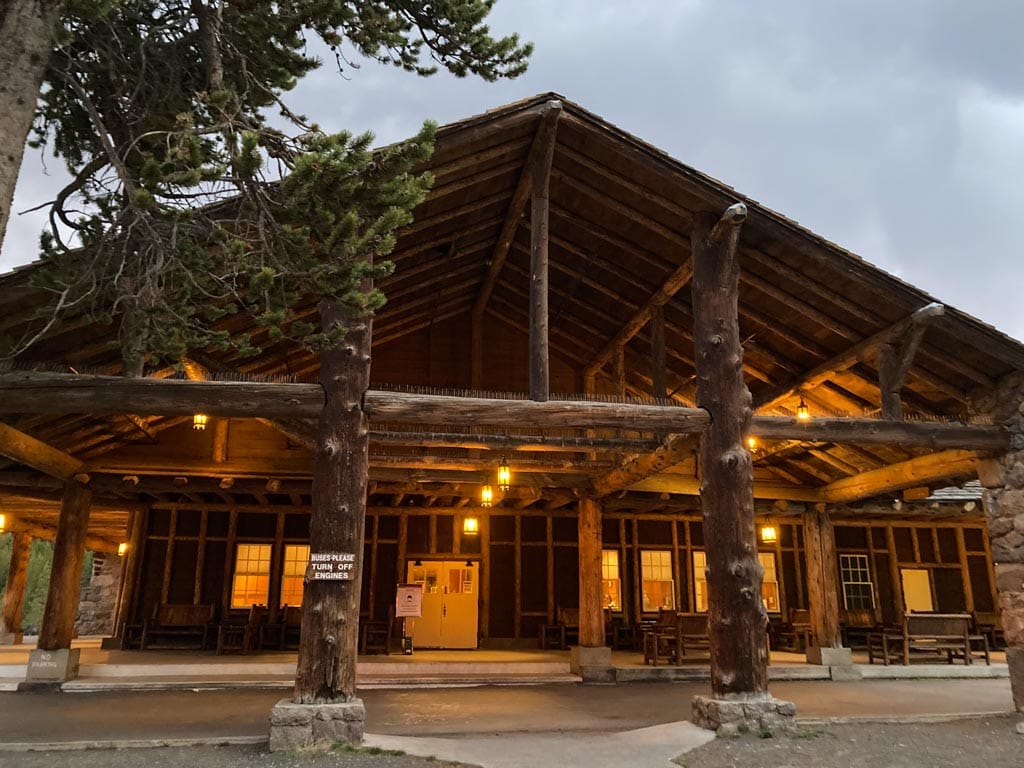
Arguably the most impressive lodge in the entire national park system, the Old Faithful Inn is the prime example of “parkitecture” and one of the absolute greatest national park lodges. Although not a natural sight, it’s still among the grandest places to visit in Yellowstone.
One of the last remaining log hotels in America, this rustic lodge is an absolute must see in Yellowstone National Park.
It was constructed during the winter of 1903-1904 and features a steep roof, five-story-high lobby, gigantic stone fireplace, mesmerizing wooden decorations and furnishings, and beautiful gabled dormers.
It is a spectacular building, which greatly influenced park architecture later on. Nowadays, you can still stay at the Old Faithful Inn, certainly one of the very best national park experiences in the country. A cheaper accommodation option nearby are the cabins at Old Faithful Lodge.
Black Sand & Biscuit Basins
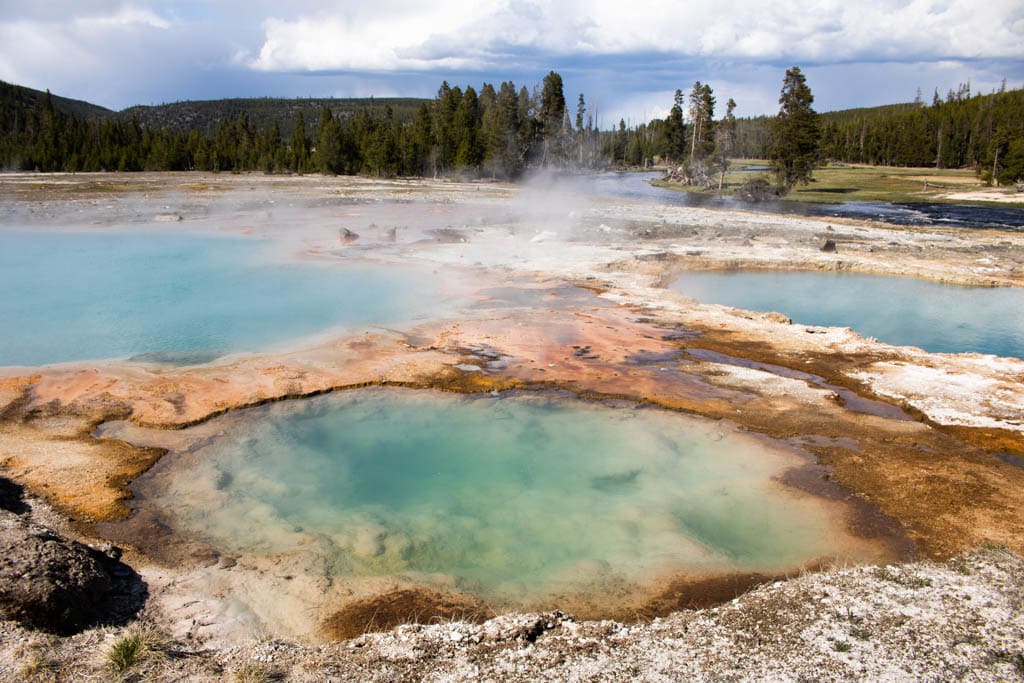
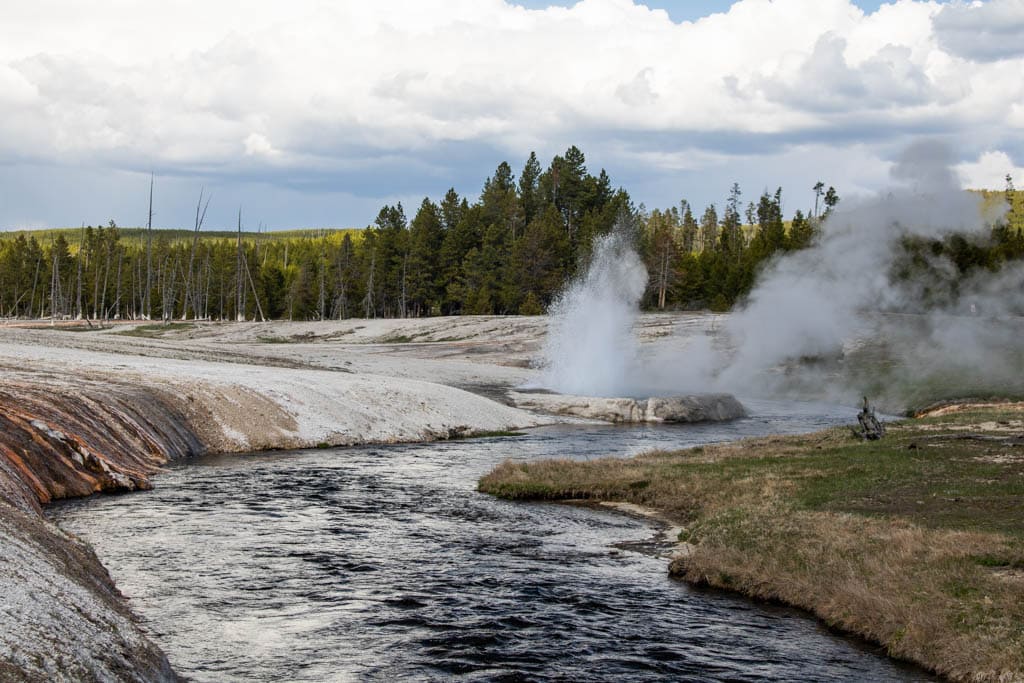
Even though they’re technically a part of the Upper Geyser Basin, the Black Sand and Biscuit Basins are a bit further from Old Faithful.
It is possible to walk to Black Sand Basin from Old Faithful (a 4-mile roundtrip hike) or you can drive about 1.6 miles. This beautiful geyser basin gets its name from sand derived from obsidian, a black volcanic glass, and is home to some of Yellowstone National Park’s most beautiful hot springs.
A short boardwalk loops around Black Sand Basin, passing stunning springs like Emerald Pool, Sunset Lake and Rainbow Pool on the way. One of the park’s most frequently erupting geysers, Cliff Geyser goes off every few minutes.
Biscuit Basin, on the other hand, is about 3 miles north of Old Faithful by car. You can also get there on foot by continuing past Morning Glory Pool, which is a 5.2-mile roundtrip hike from Old Faithful.
There, another boardwalk brings you close to a number of geysers and hot springs, most notably Sapphire Pool and Black Opal Pool.
Grand Prismatic Spring & Midway Geyser Basin
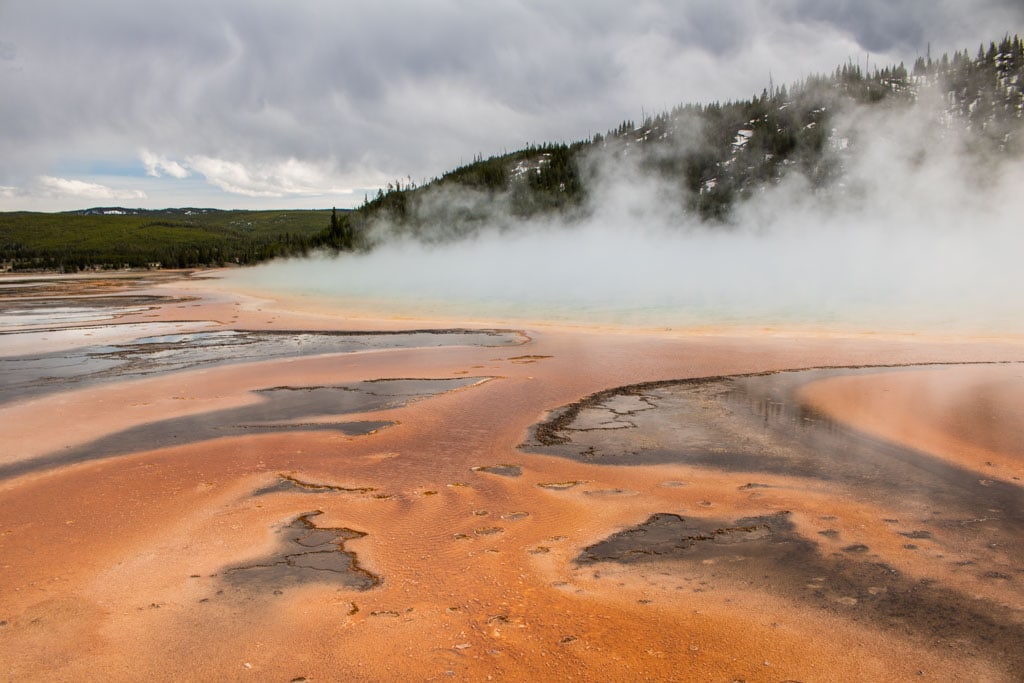
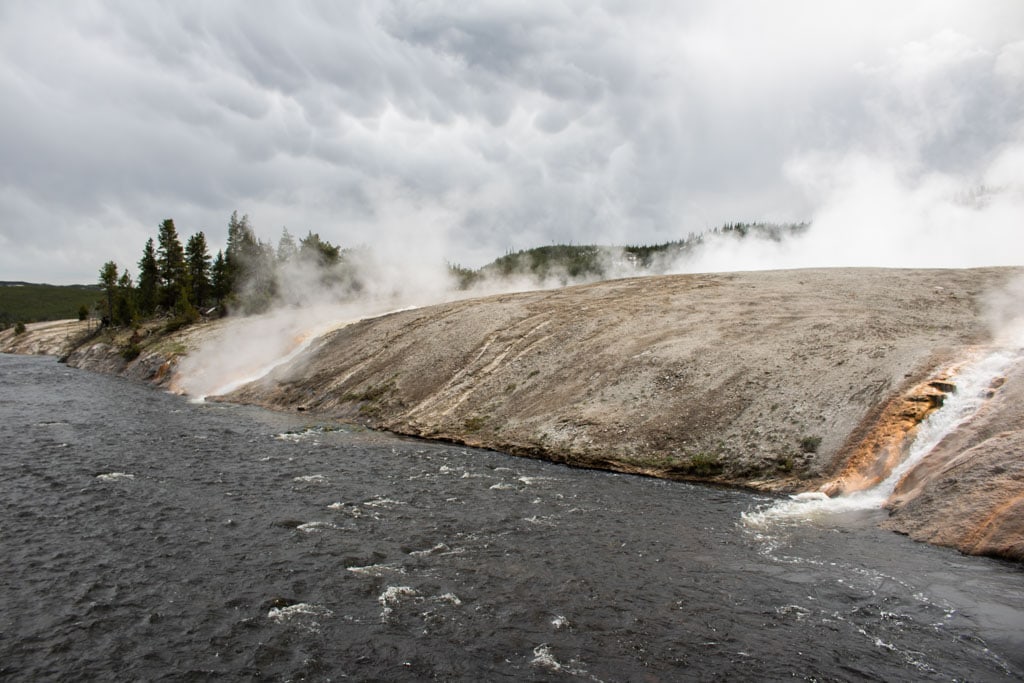
One of the most popular places to visit in Yellowstone National Park is Grand Prismatic Spring at Midway Geyser Basin.
The third-largest hot spring on Earth, this giant pool of steaming water has a diameter of 370 feet and is 121 feet deep. It’s an absolute natural wonder and among the things not to miss in Yellowstone.
A boardwalk runs past the Grand Prismatic Spring, offering close-up views of its vibrant colors, which radiate out in concentric circles from its stunningly blue depths. Each color corresponds with a certain water temperature, which supports different bacterial life, the so-called thermophiles.
Additionally, for a bird’s eye view of this magnificent hot spring, you can hike the Fairy Falls Trail to a crowded viewpoint.
Note, however, that this trail is not open in spring, when it’s off limits to visitors due to bear activity. When it is open, this viewpoint is certainly one of the best places to visit in Yellowstone.
The Midway Geyser Basin boardwalk also loops along the crater of Excelsior Geyser. Although this is a dormant geyser, it’s still an exceptionally active hot spring, discharging over 4,000 gallons of hot water into the Firehole River every single minute.
Fountain Paint Pot & Lower Geyser Basin
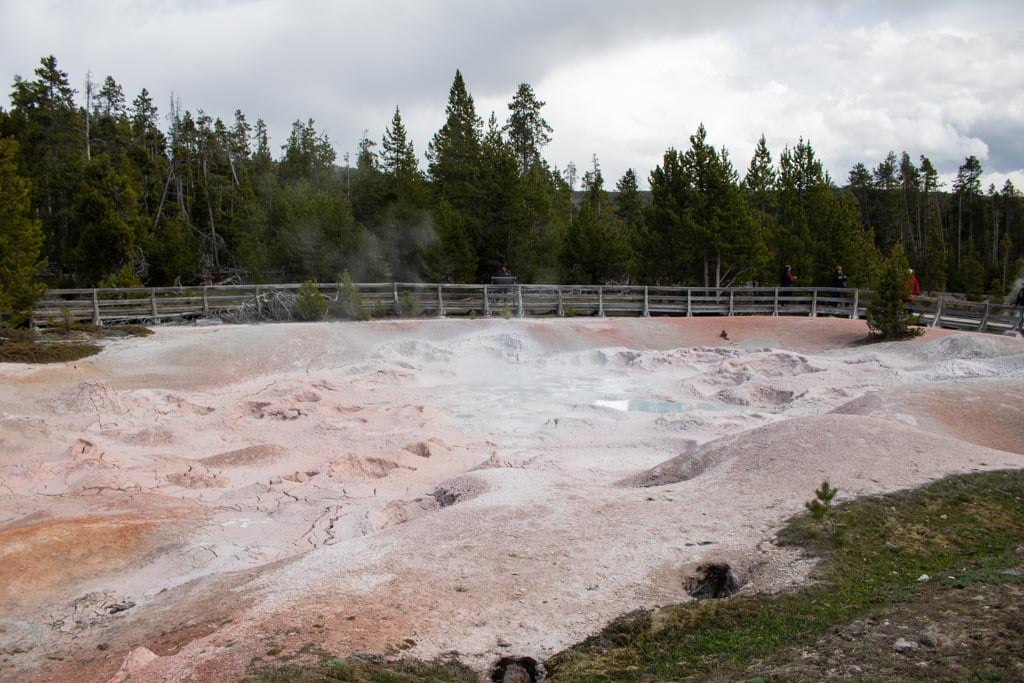
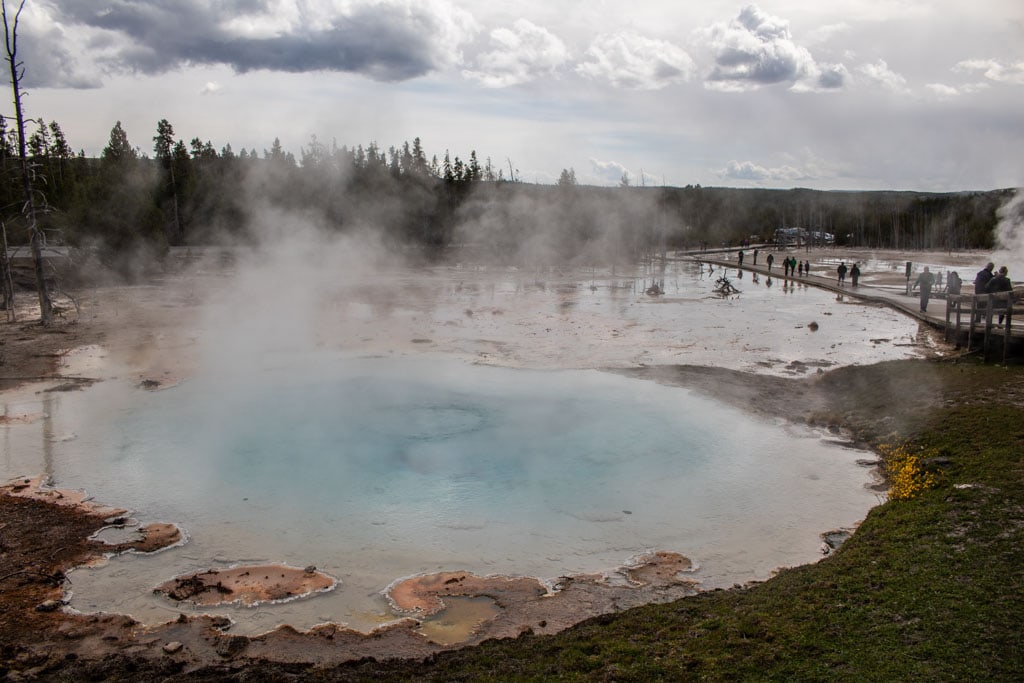
Often bypassed by hurried visitors on their way to or from Old Faithful, the Lower Geyser Basin has a few fascinating Yellowstone attractions, too.
You can drive the wonderful 3-mile one-way Firehole Lake Drive (closed in spring for bear management) and see its eight different thermal features.
The main highlight here is Great Fountain Geyser, which erupts about every 9 to 14 hours. This is the only geyser in Yellowstone National Park outside of the Old Faithful area of which the National Park Service predicts eruptions.
Elsewhere in the Lower Geyser Basin, Fountain Paint Pot is home to all four hydrothermal features: hot springs, mud pots, fumaroles and geysers. A short 0.5-mile interpretive boardwalk loops past beautiful sights like Silex Spring and Clepsydra Geyser, which erupts almost constantly.
6. Norris
Gibbon Falls
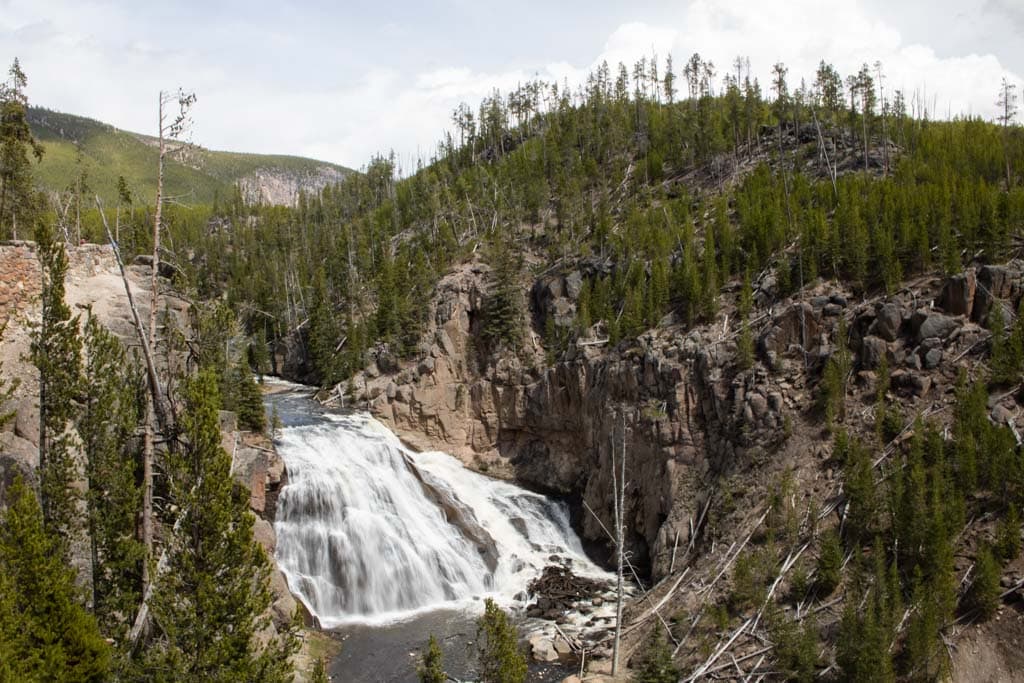
Seeing Gibbon Falls tumble 84 feet over remnants of the Yellowstone Caldera rim is as easy as it gets. This scenic waterfall is along the road between Madison and Norris, a paved walkway leading to a couple of viewpoints.
Take in this wonderful scene, contemplating that you’re actually standing at the very inner rim of the giant Yellowstone Caldera. The rock wall on the other side of the road is the caldera’s rim.
Despite its enjoying less praise and fame than, say, Old Faithful or Mammoth Hot Springs, I do consider Gibbon Falls a great stop on any Yellowstone sightseeing drive.
It’s underrated places like this, which would be much more famous if they’d been in another less-attraction-filled park, that really allow you to get a better understanding of the heart and soul of Yellowstone.
Make sure to stop here, stretch your legs, have a snack, enjoy the view.
Artists Paintpots
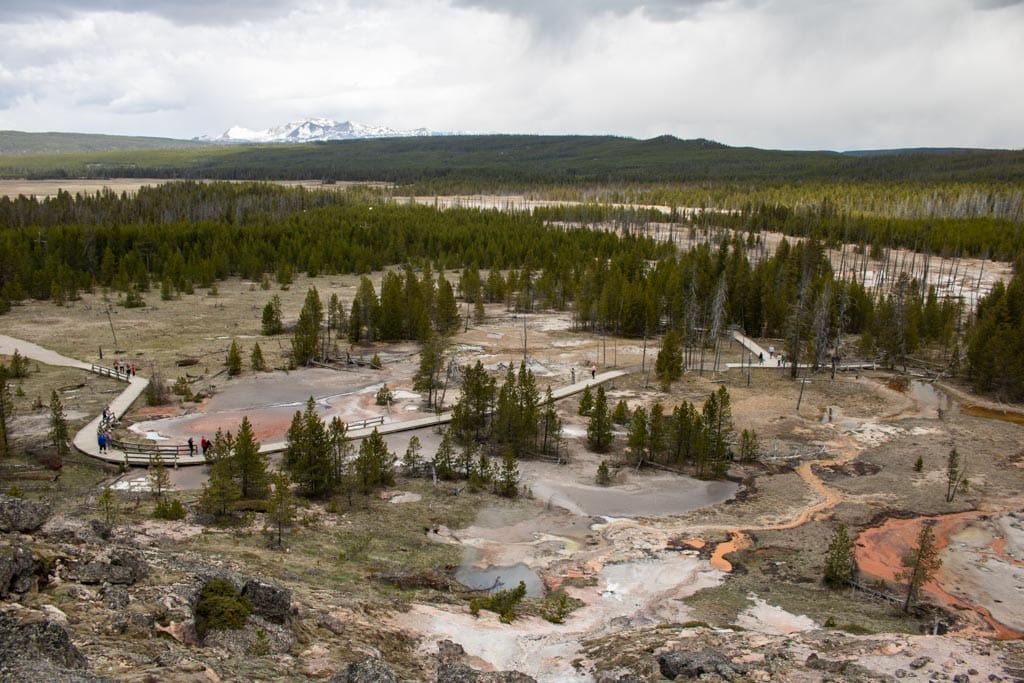
It may be a pretty small area, especially compared with some of the other, more famous places to visit in Yellowstone National Park, but Artists Paintpots is definitely interesting and lovely.
Located about 4 miles south of Norris, it is home to a group of colorful hot springs and lively mud pots. These pools of hot mud bubble and burst continuously, often in noisy spurts that can catapult mud 10 feet into the air.
The best views of Artists Paintpots are from the top of the 1-mile lollipop boardwalk/trail.
Norris Geyser Basin
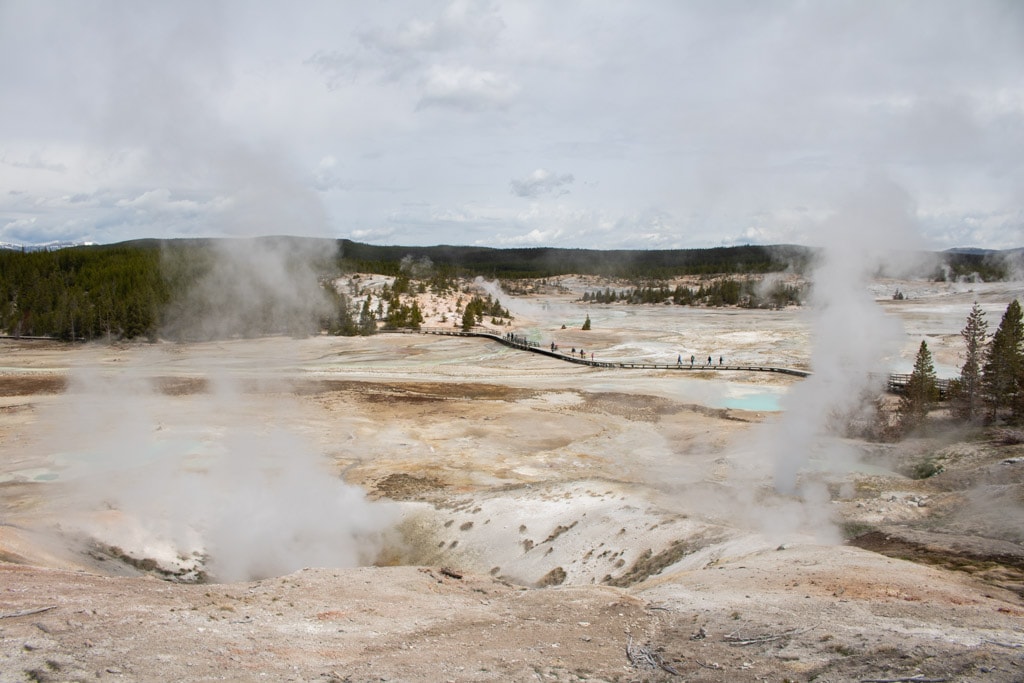
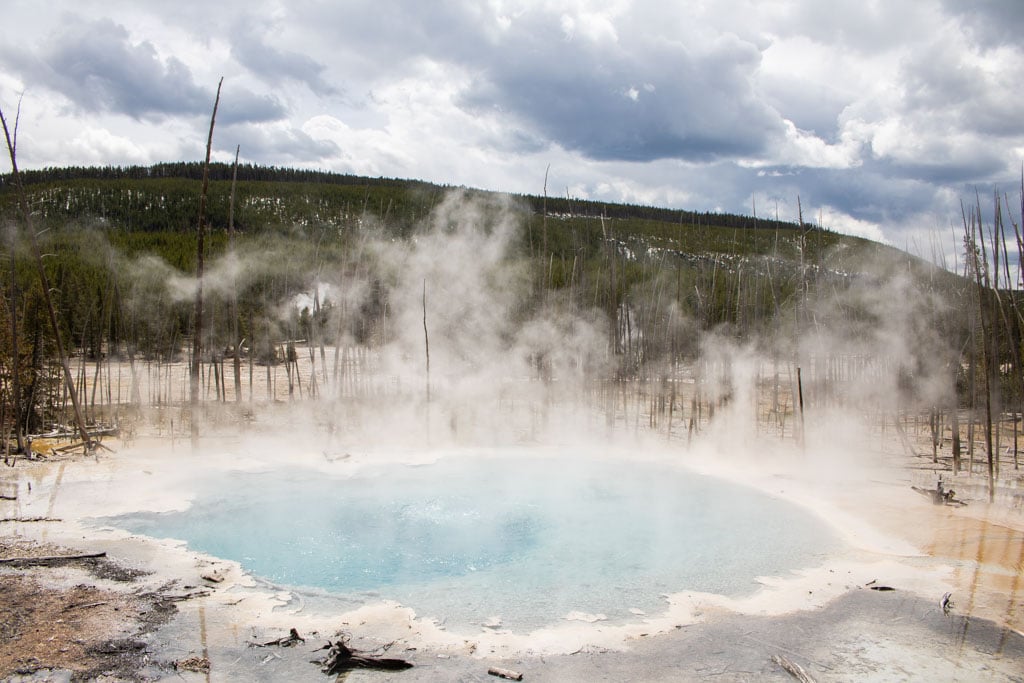
One of the hottest and most acidic thermal areas in Yellowstone National Park, Norris Geyser Basin is extremely volatile and dynamic. This is an active earthquake area, set at the intersection of three major faults.
The result of these conditions is a geyser basin dotted with huge hot springs and massive geysers. Every year, Norris looks a bit different as features appear, go dormant or come back to life.
Hot springs can suddenly turn into geysers, while geysers may calm down and become muddy pools. At Norris, it seems like everything is possible.
This is one of my favorite places to visit in Yellowstone Park. You can feel the energy here. The Norris Geyser Basin is split up into two separate basins. A 0.75-mile boardwalk loops around Porcelain Basin, the smallest of the two, taking in features like Crackling Lake, Hurricane Vent and Whirligig Geyser.
You can explore the larger Back Basin on a 1.5-mile boardwalk loop trail. This is where you’ll find Norris Geyser Basin’s most famous and arguably beautiful features. The vibrant blues of Cistern Spring and Emerald Spring are amazing to look at, while Echinus Geyser is the largest known acidic geyser on the planet.
The star attraction at Back Basin, however, is Steamboat Geyser. Eruptions may be days, months or even years apart, but when it does go off, this is the tallest geyser in the world, throwing water over 300 feet high.
Seeing Steamboat Geyser erupt is truly one of the most unique things to do in Yellowstone National Park—but you do have to be very lucky to be there at the right time. After a major eruption, which could last from 3 to 40 minutes, Steamboat continues to roar with steam for hours.
Roaring Mountain
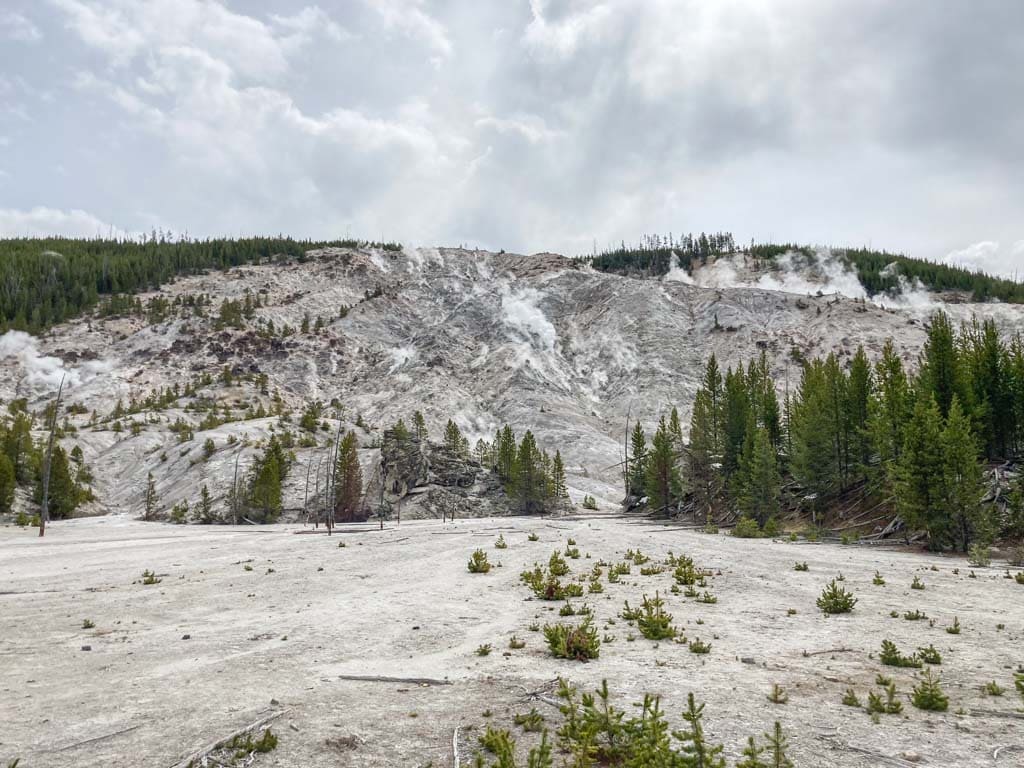
Situated just up the road from Norris toward Mammoth, Roaring Mountain is a massive slope filled with fumaroles. It looks as if the mountain is on fire inside, which it pretty much is, with its dozens of steam vents hissing, whistling and puffing.
10 Books to Read Before Your Visit to Yellowstone
- Empire of Shadows: The Epic Story of Yellowstone – George Black
- Deep Into Yellowstone: A Year’s Immersion in Grandeur & Controversy – Rick Lamplugh
- Yellowstone Ranger: Stories from a Life in Yellowstone – Jerry Mernin
- Decade of the Wolf: Returning the Wild to Yellowstone – Douglas Smith & Gary Ferguson
- The Reign of Wolf 21: The Saga of Yellowstone’s Legendary Druid Pack – Rick McIntyre
- Wild Rescues: A Paramedic’s Extreme Adventures in Yosemite, Yellowstone and Grand Teton – Kevin Grange
- Bring Jade Home: The True Story of a Dog Lost in Yellowstone and the People Who Searched for Her – Michelle Caffrey
- Taken by Bear in Yellowstone: More Than a Century of Harrowing Encounters between Grizzlies and Humans – Kathleen Snow
- Death in Yellowstone: Accidents and Foolhardiness in the First National Park – Lee H. Whittlesey
- Yellowstone and Grand Teton National Parks (Full-Color Travel Guide) – Fodor’s Compass Guides
Wildlife Safety in Yellowstone National Park
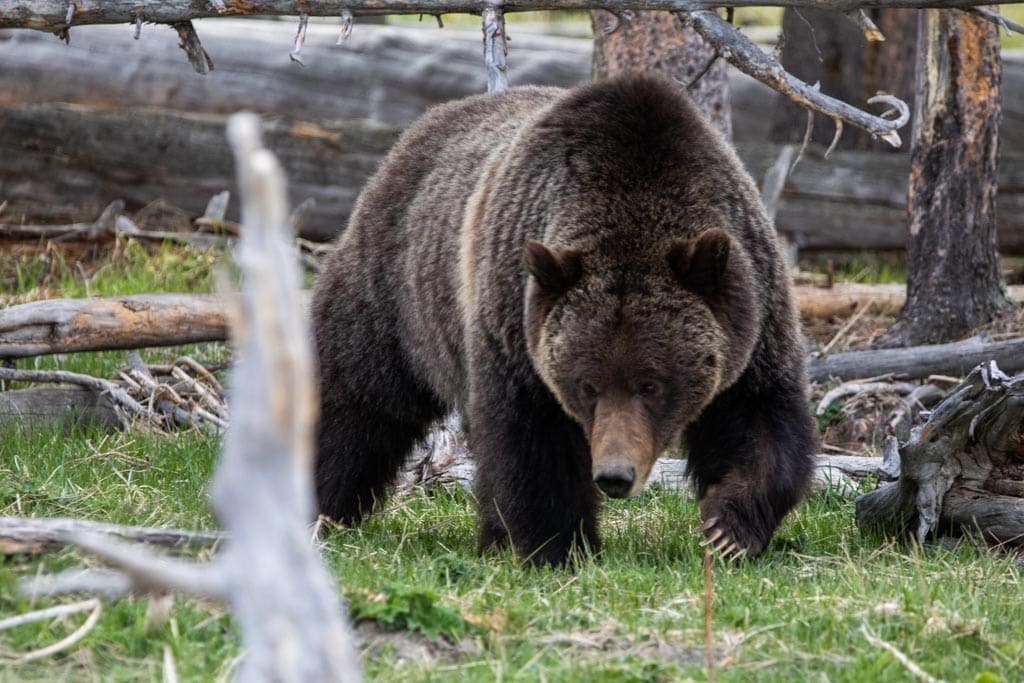
Seeing large wild animals in their natural habitat is easily one of the most popular things to do in Yellowstone, but caution is advised. The Yellowstone wildlife is very much wild. From bison, elk and moose to bears and wolves, these animals can be dangerous.
In order to keep yourself and the animals safe while visiting Yellowstone National Park, it’s important to follow some basic guidelines and regulations.
These really aren’t difficult to understand, yet people ignore them every year and get seriously hurt or even die from wildlife encounters.
- Stay at least 100 yards away from bears and wolves, and minimum 25 yards from all other wildlife.
- Never approach a wild animal.
- Use binoculars, a spotting scope or telephoto lens to observe and/or photograph animals.
- Always carry bear spray!
- If your presence causes an animal to move or react, you’re too close. Move away.
- Park in roadside pullouts to watch wildlife. Always make sure all wheels are completely off the road.
At literally all these places to visit in Yellowstone National Park, there are wild animals around. That includes crowded Old Faithful, where bison and even grizzlies are not uncommon. So, for more information about recreating among and observing wildlife, I’d like to refer to the following individual wildlife safety guides.

